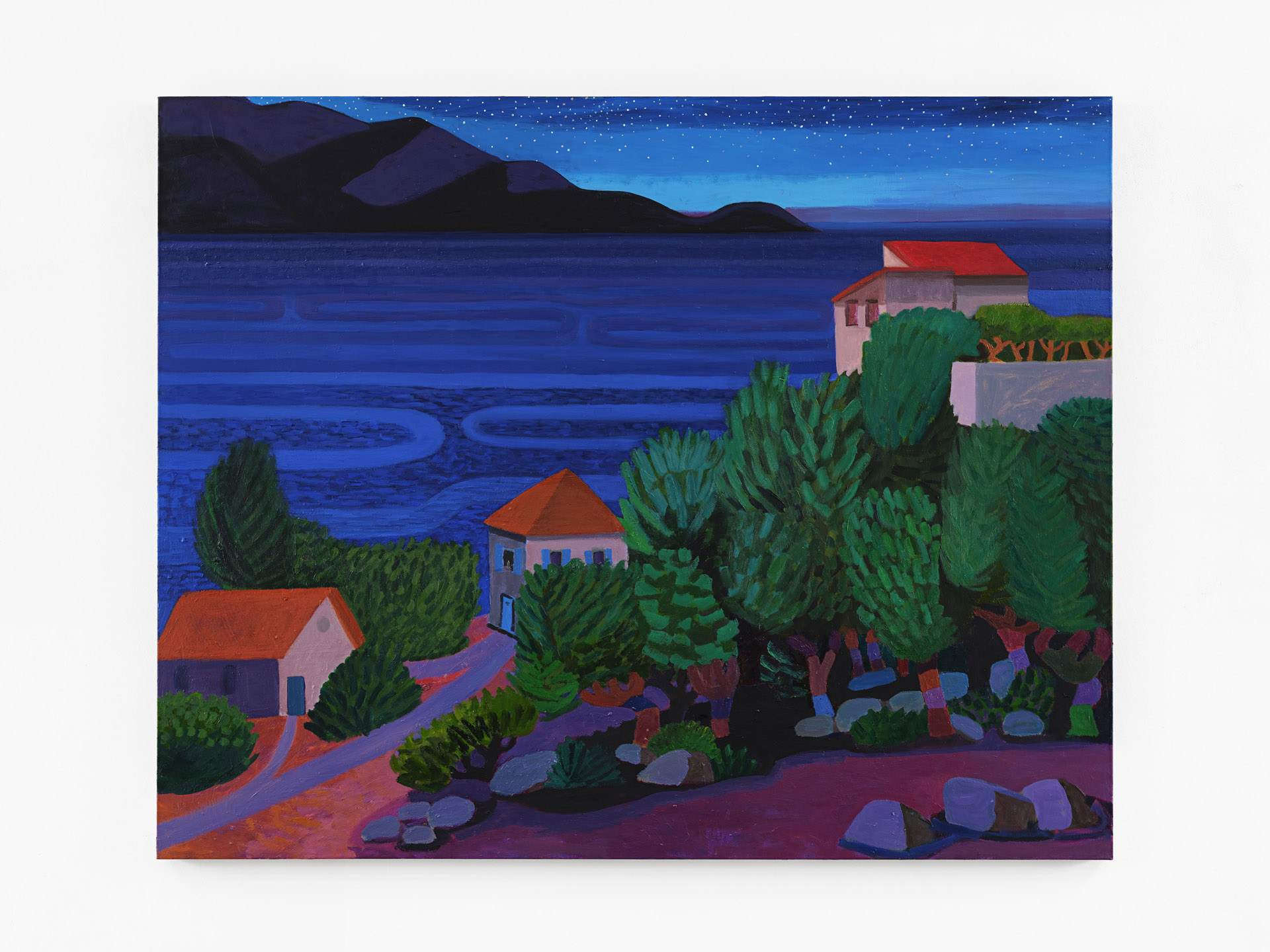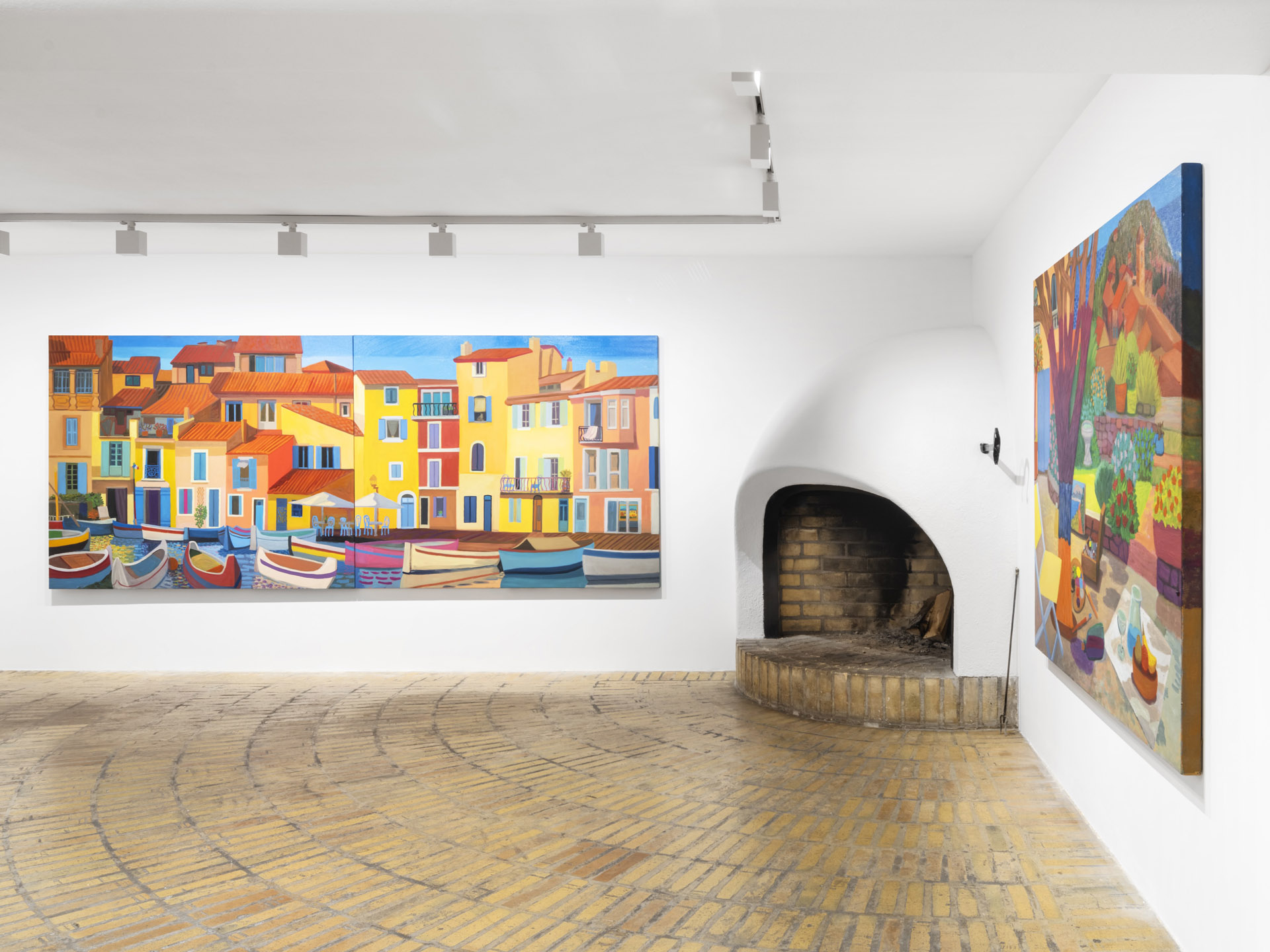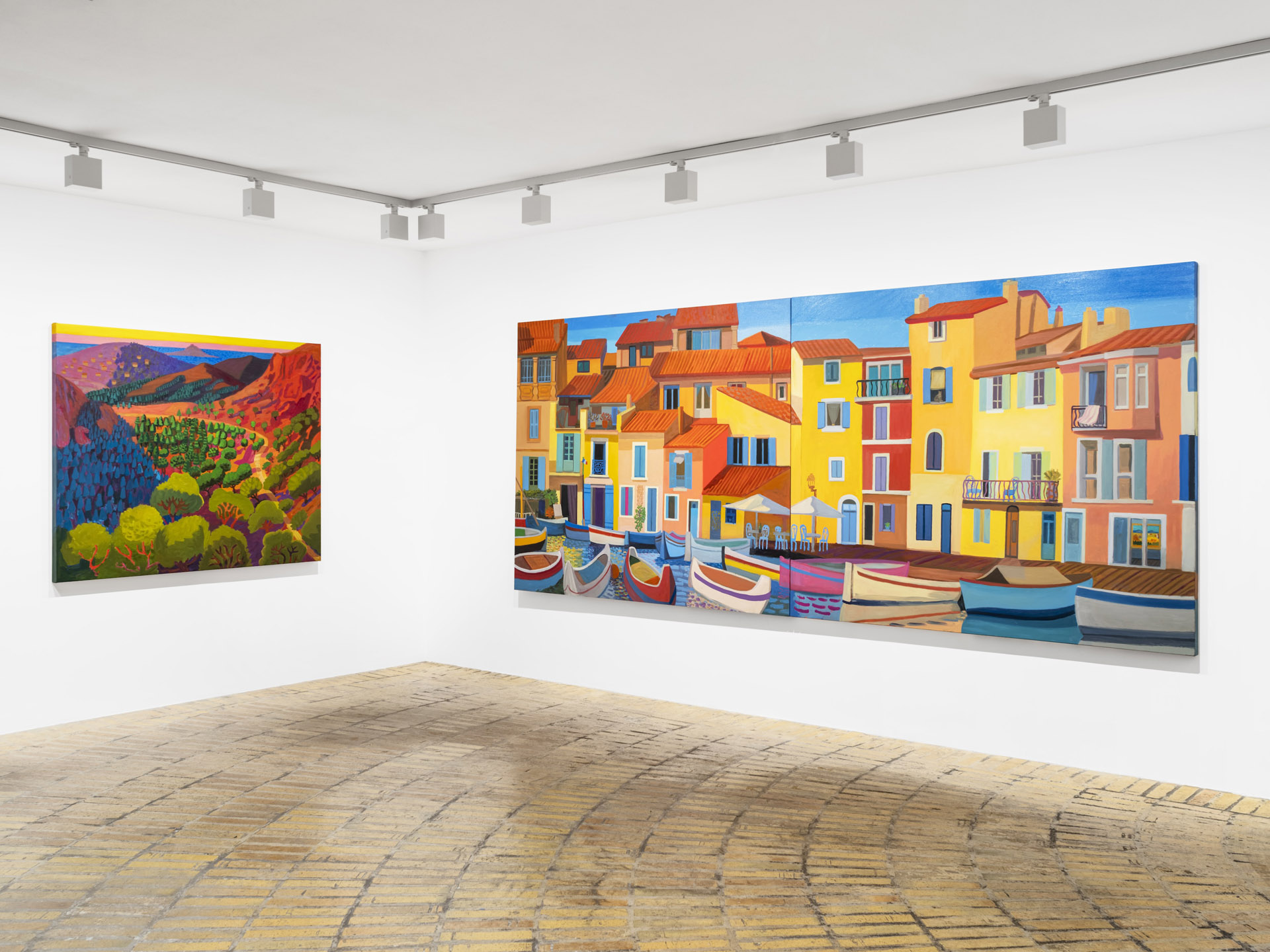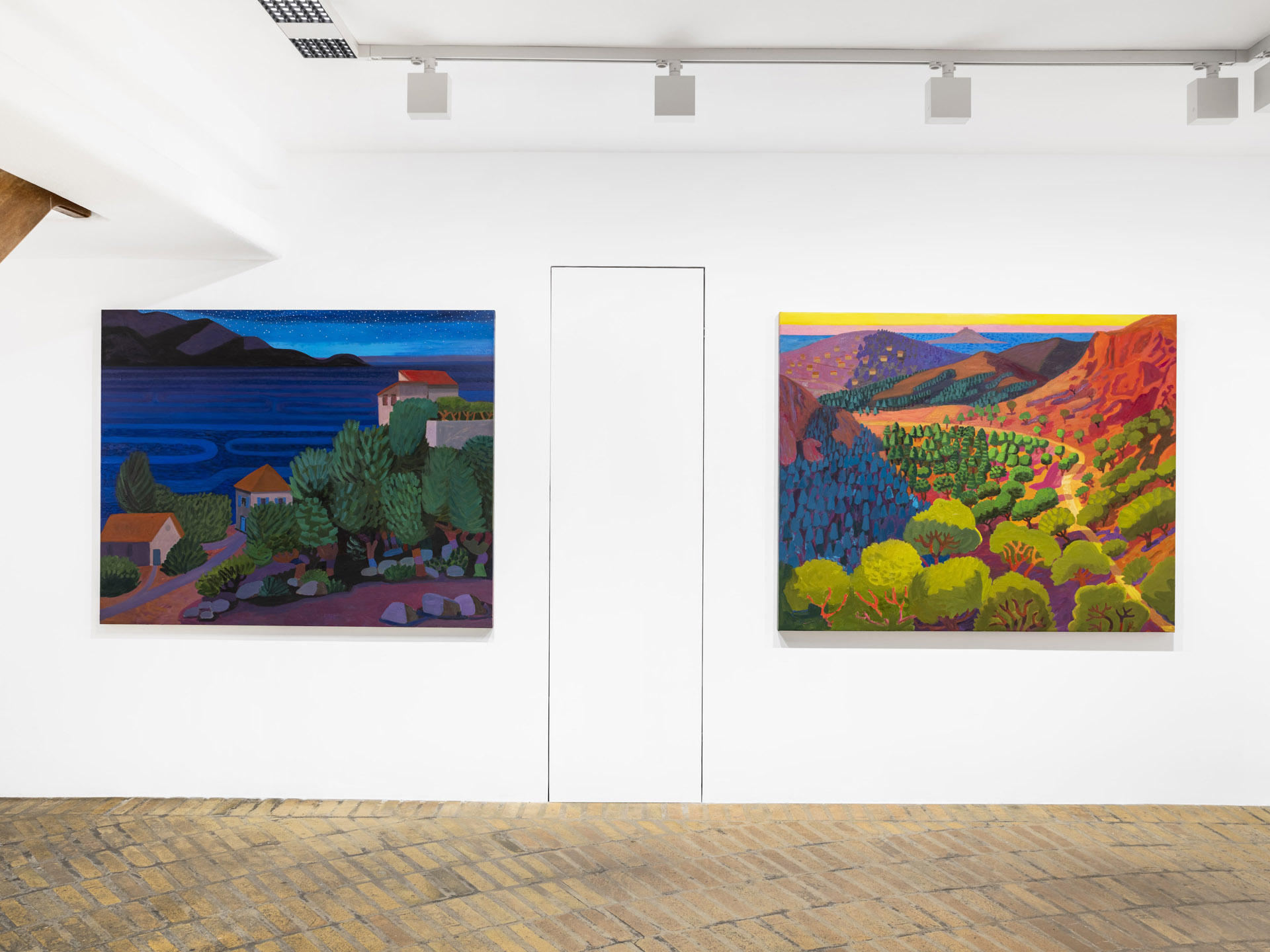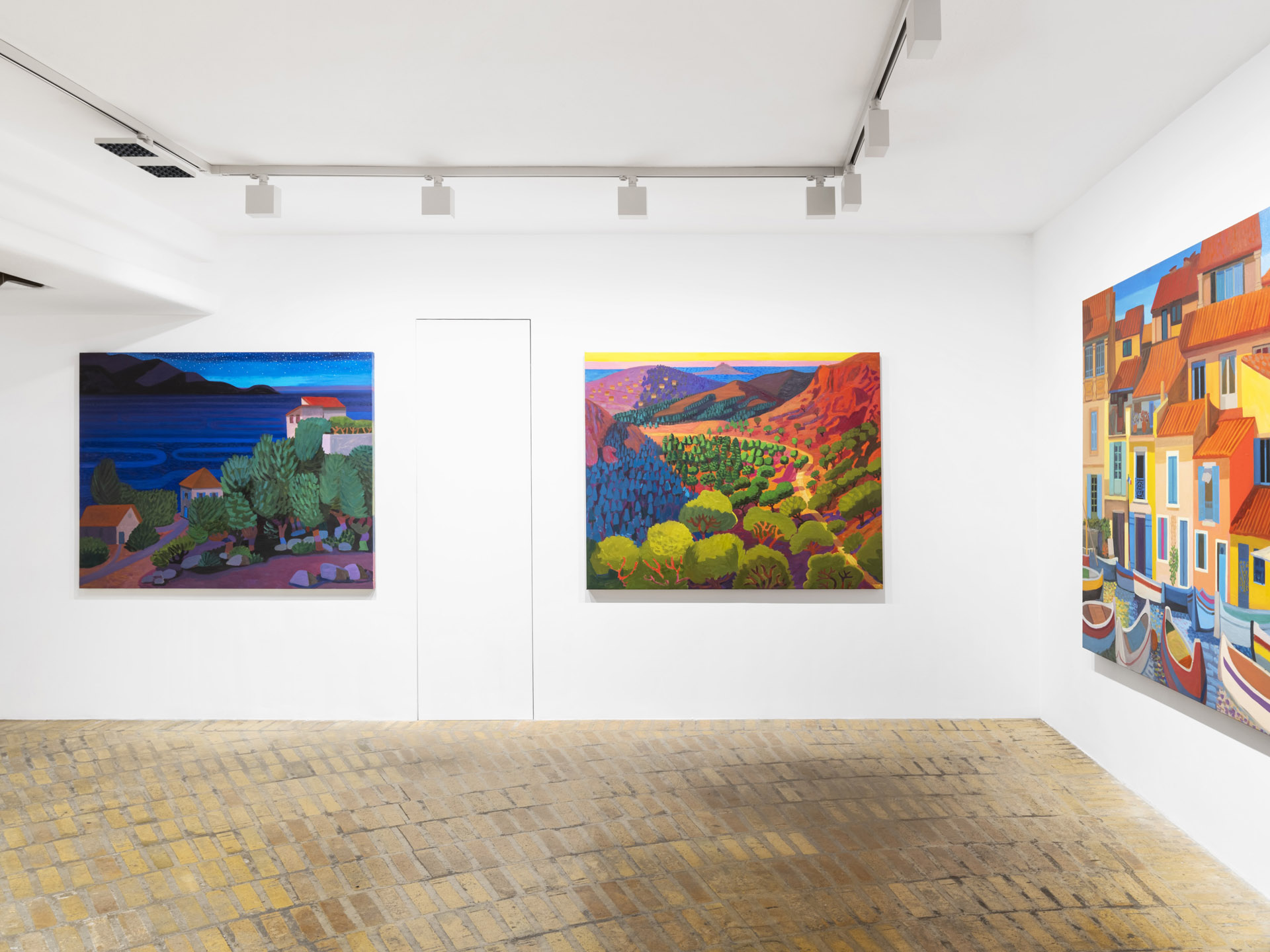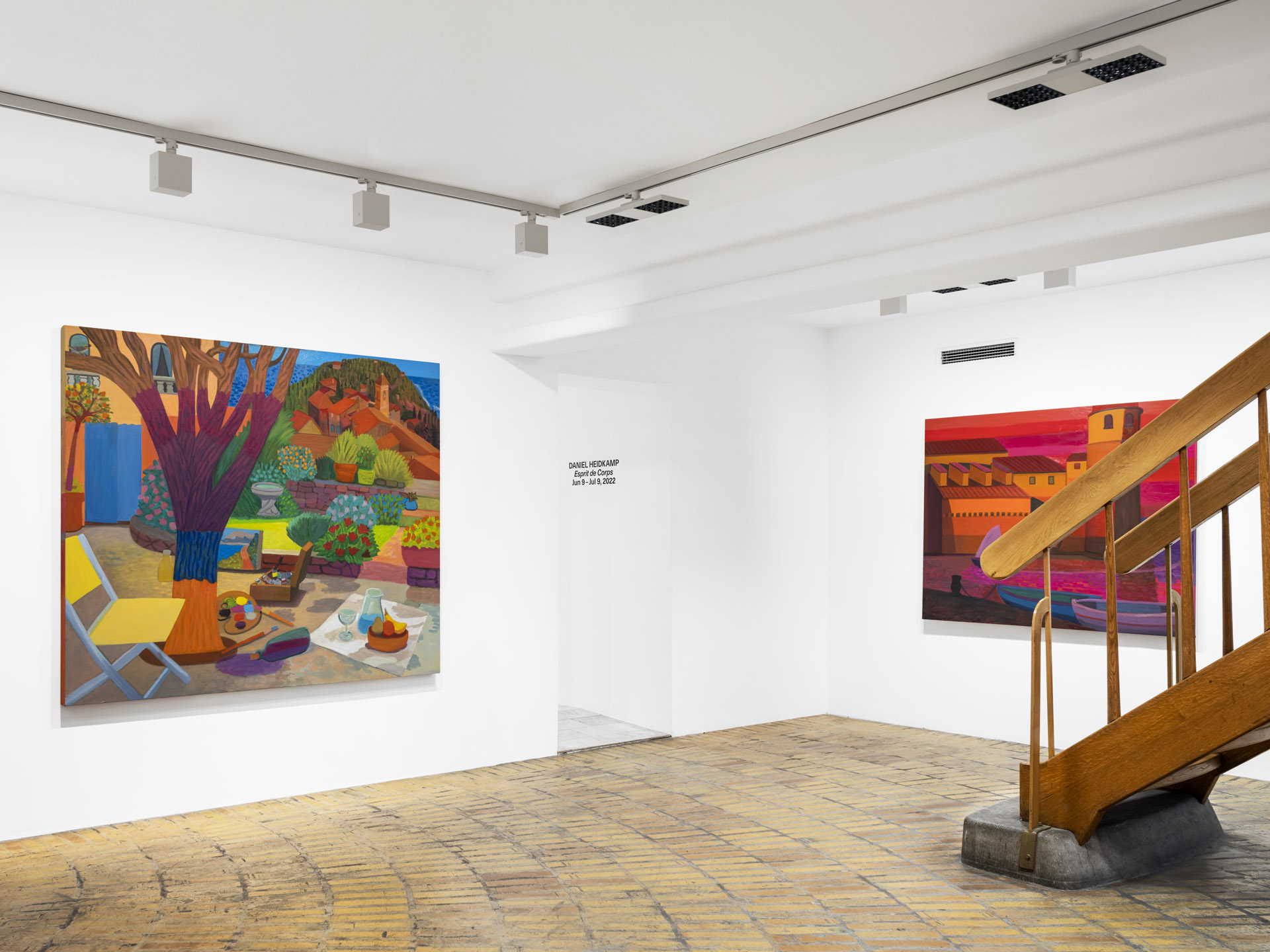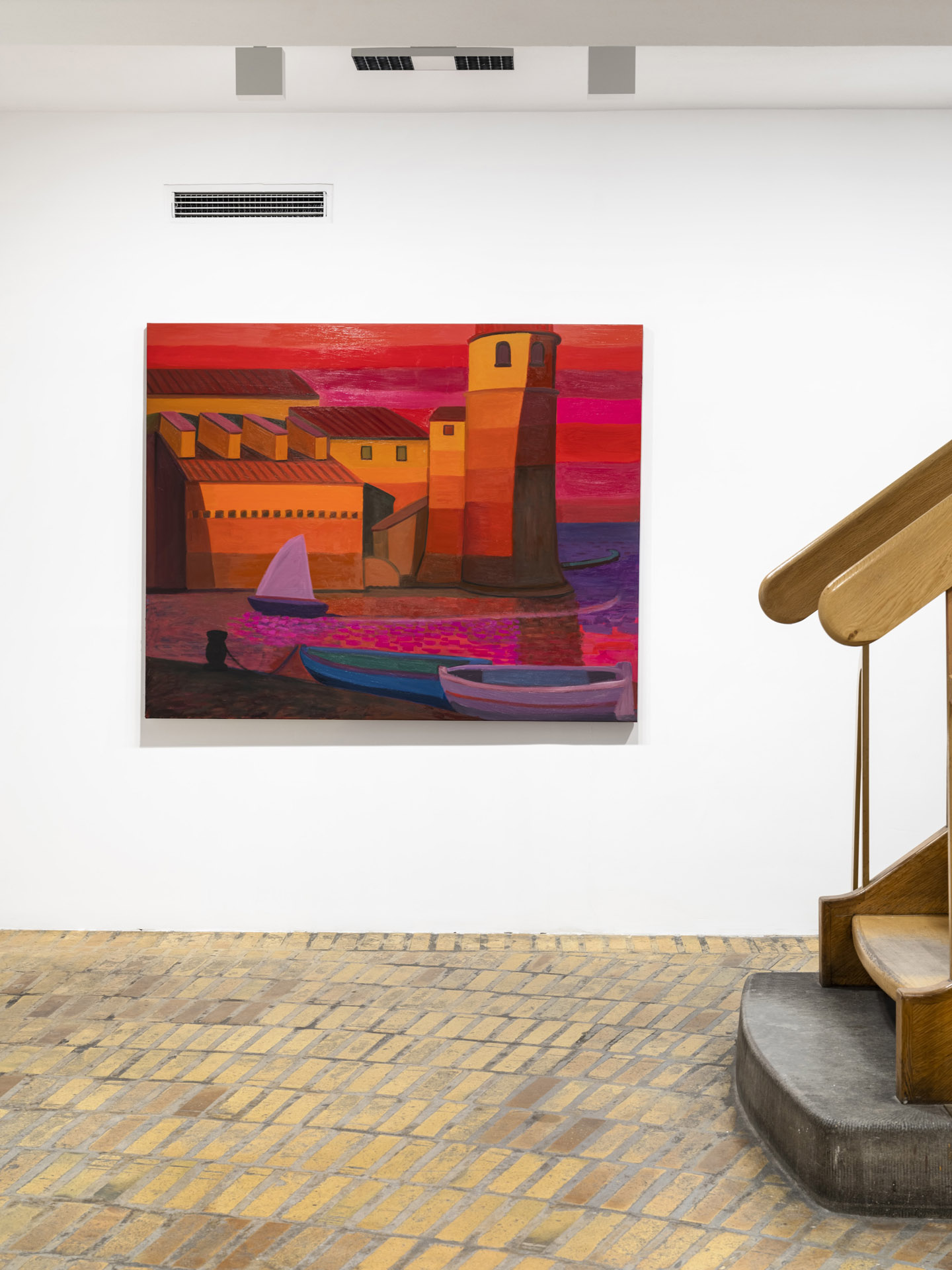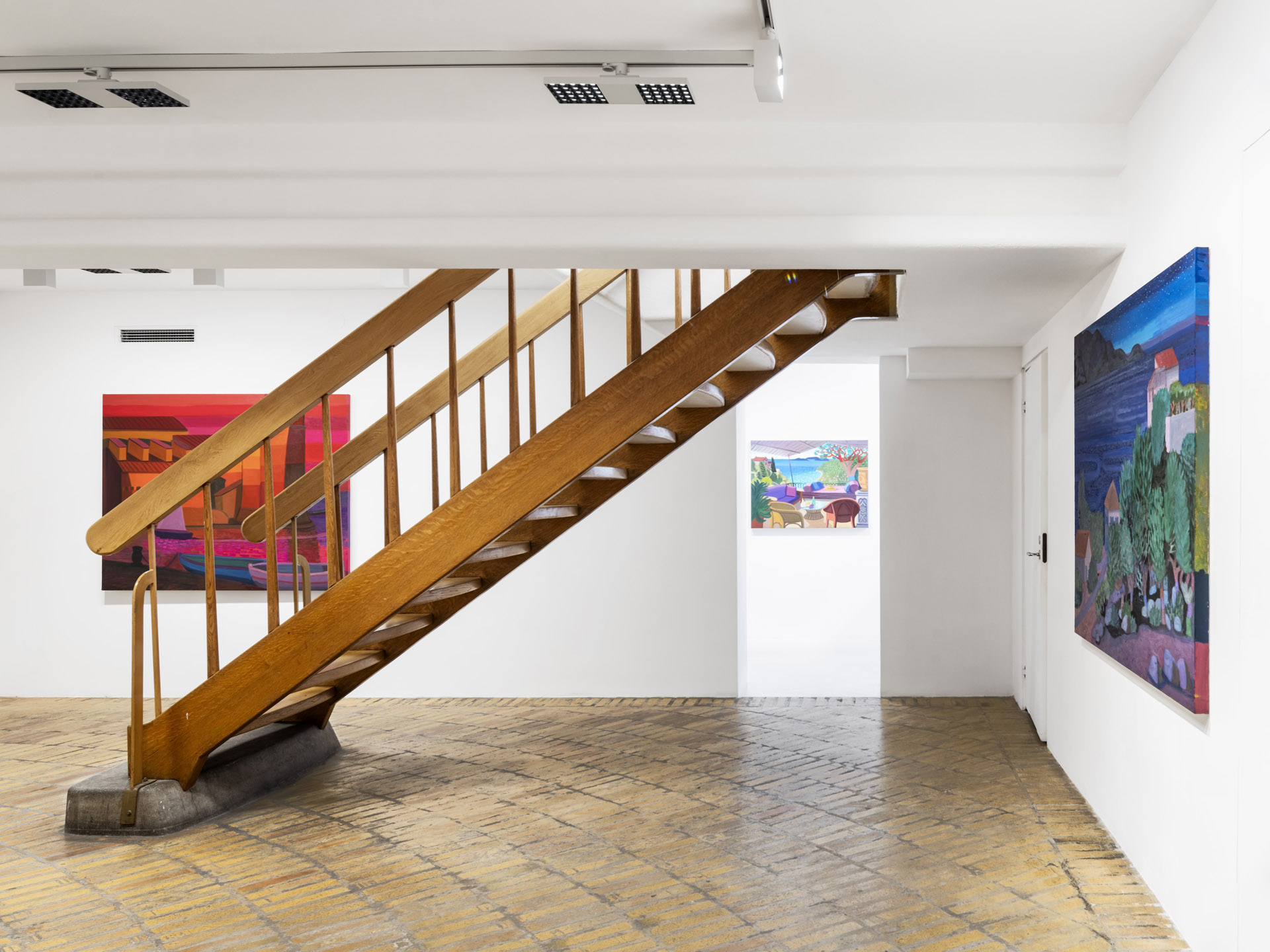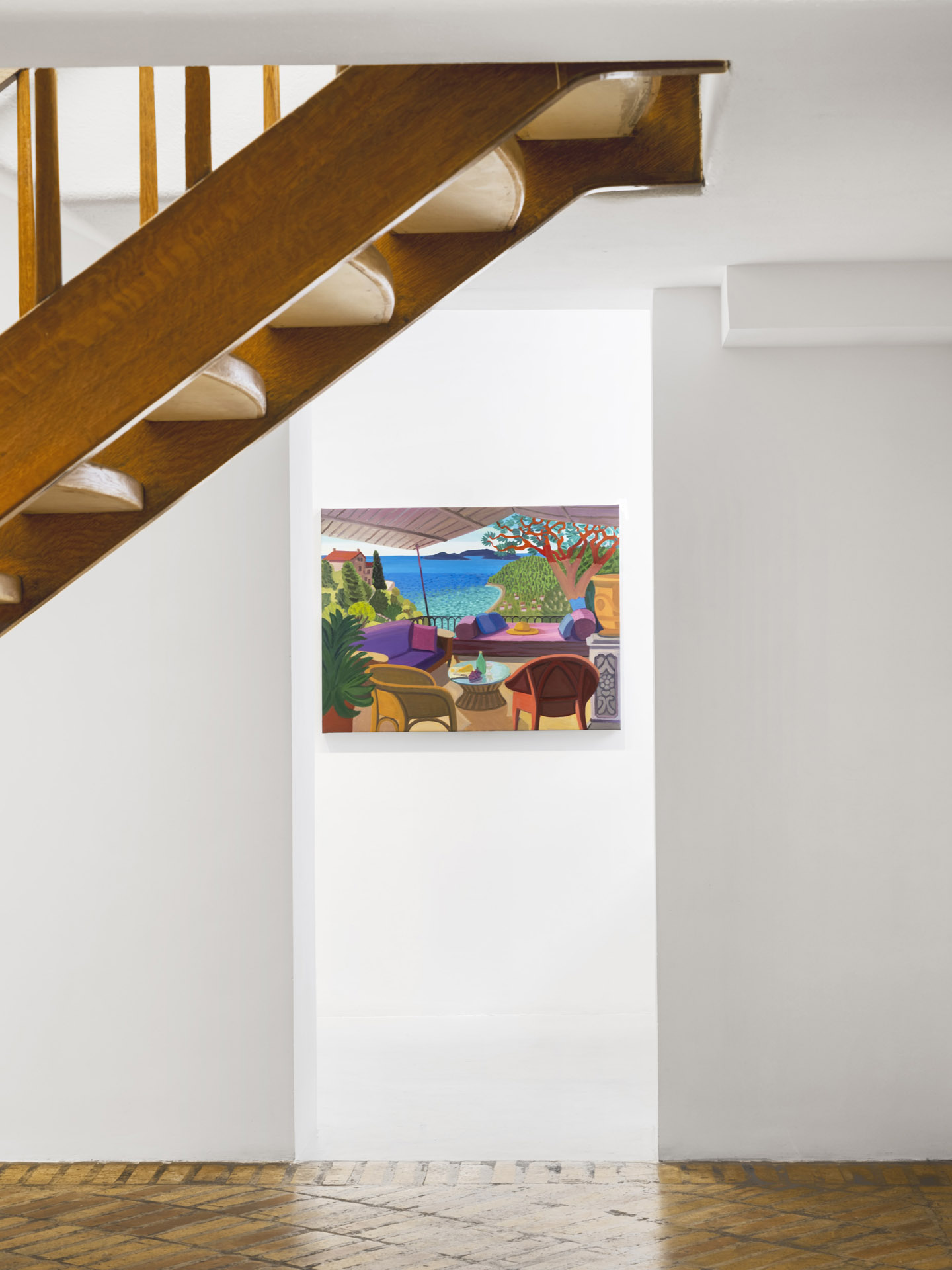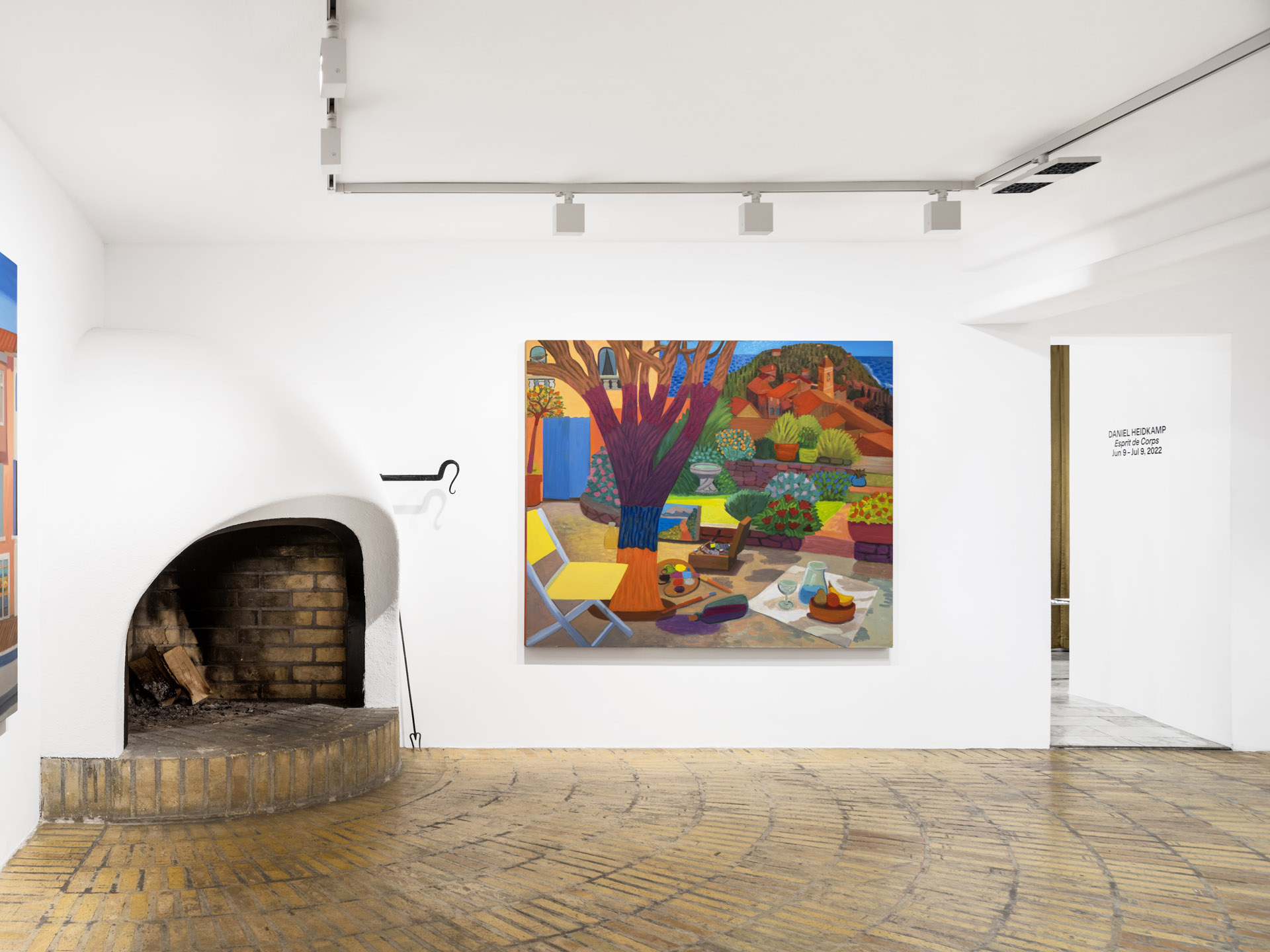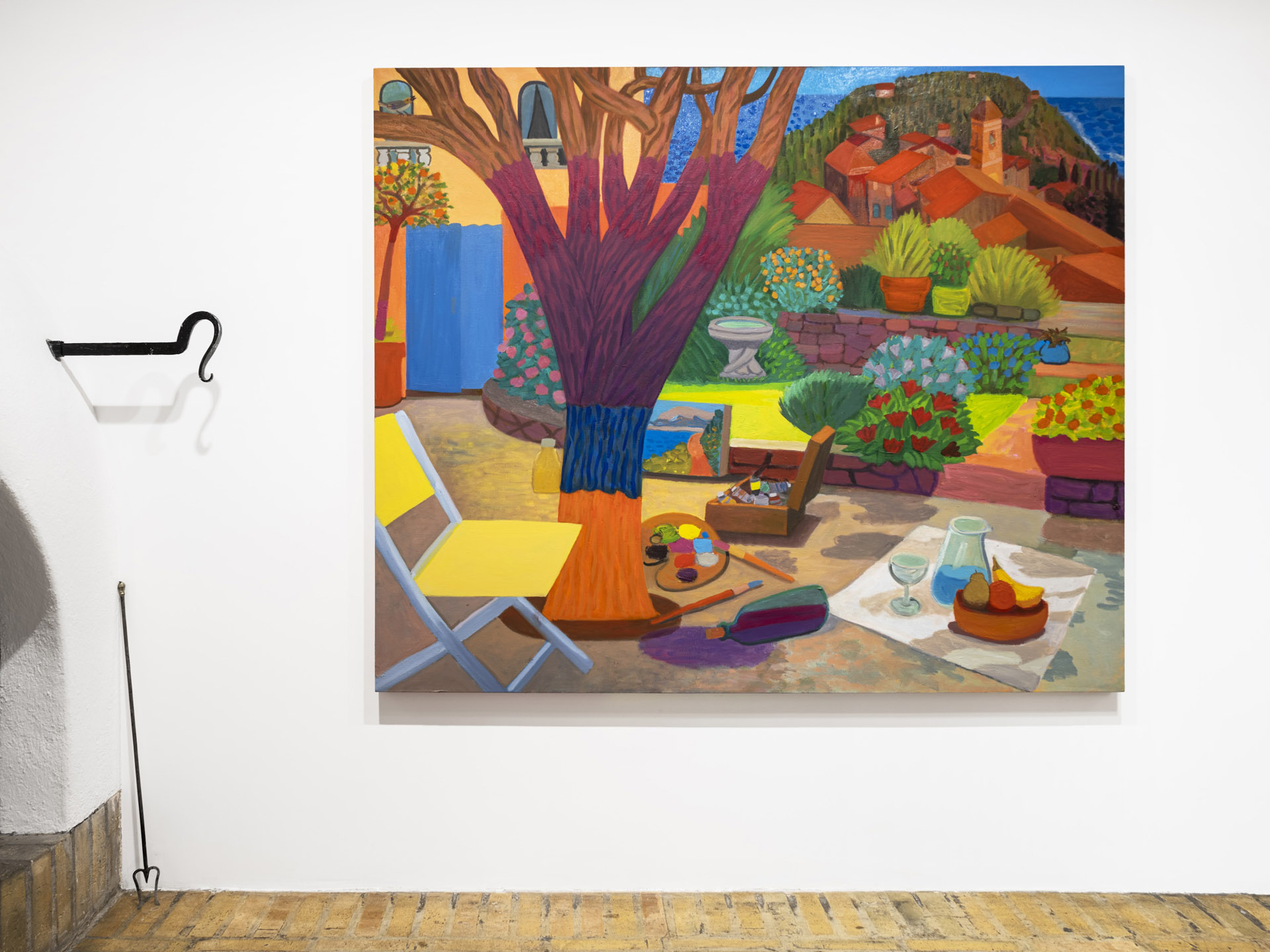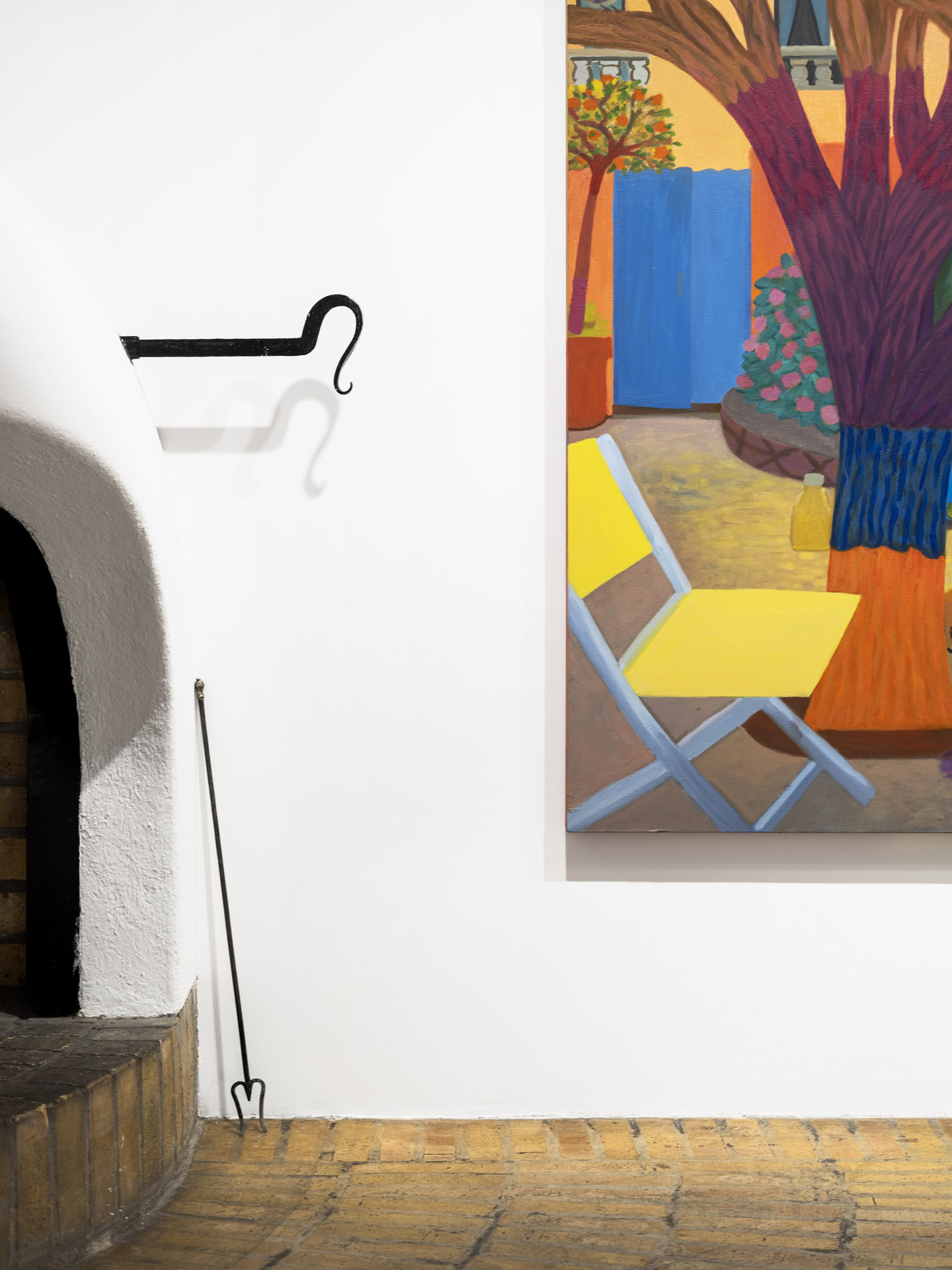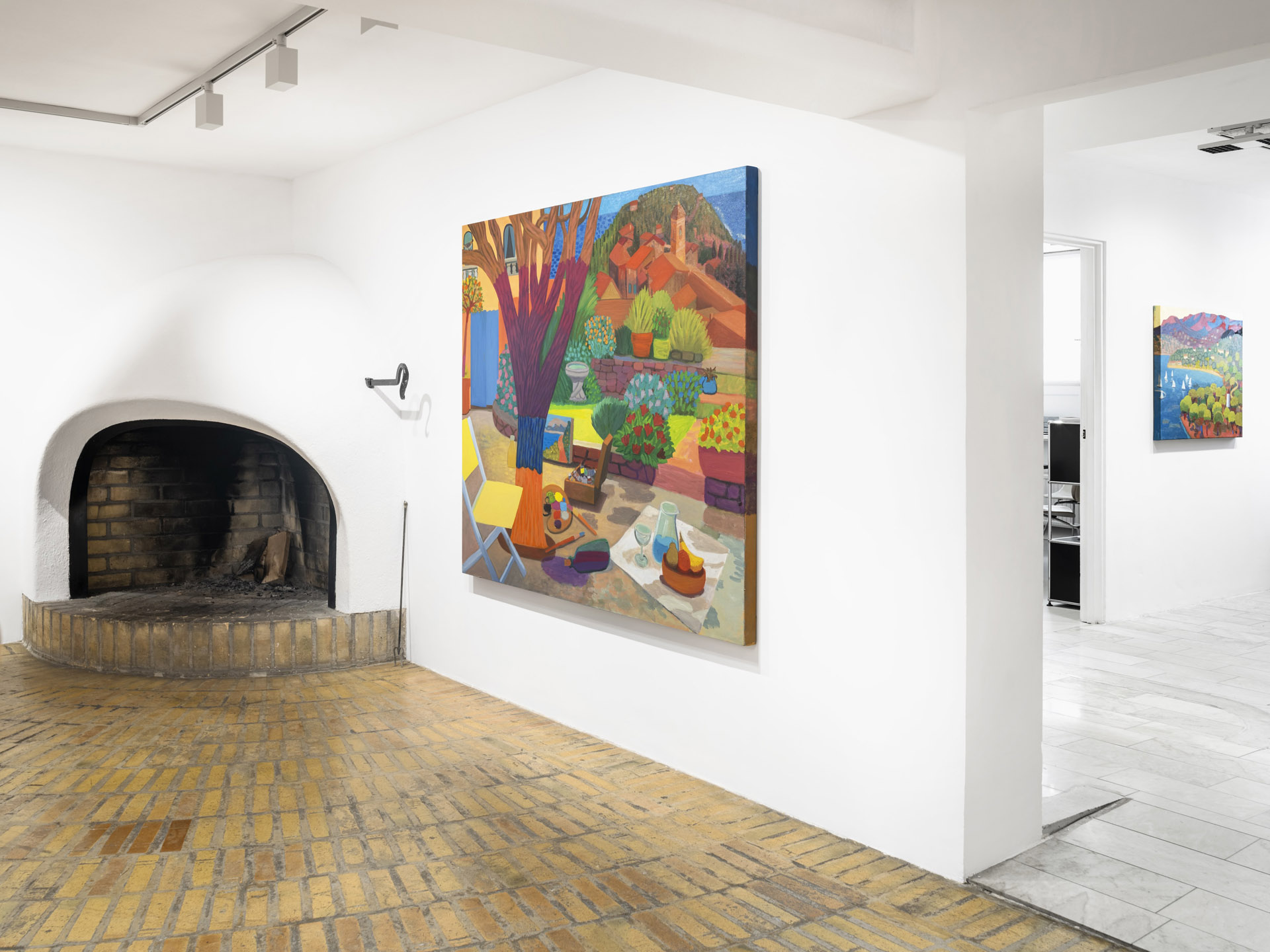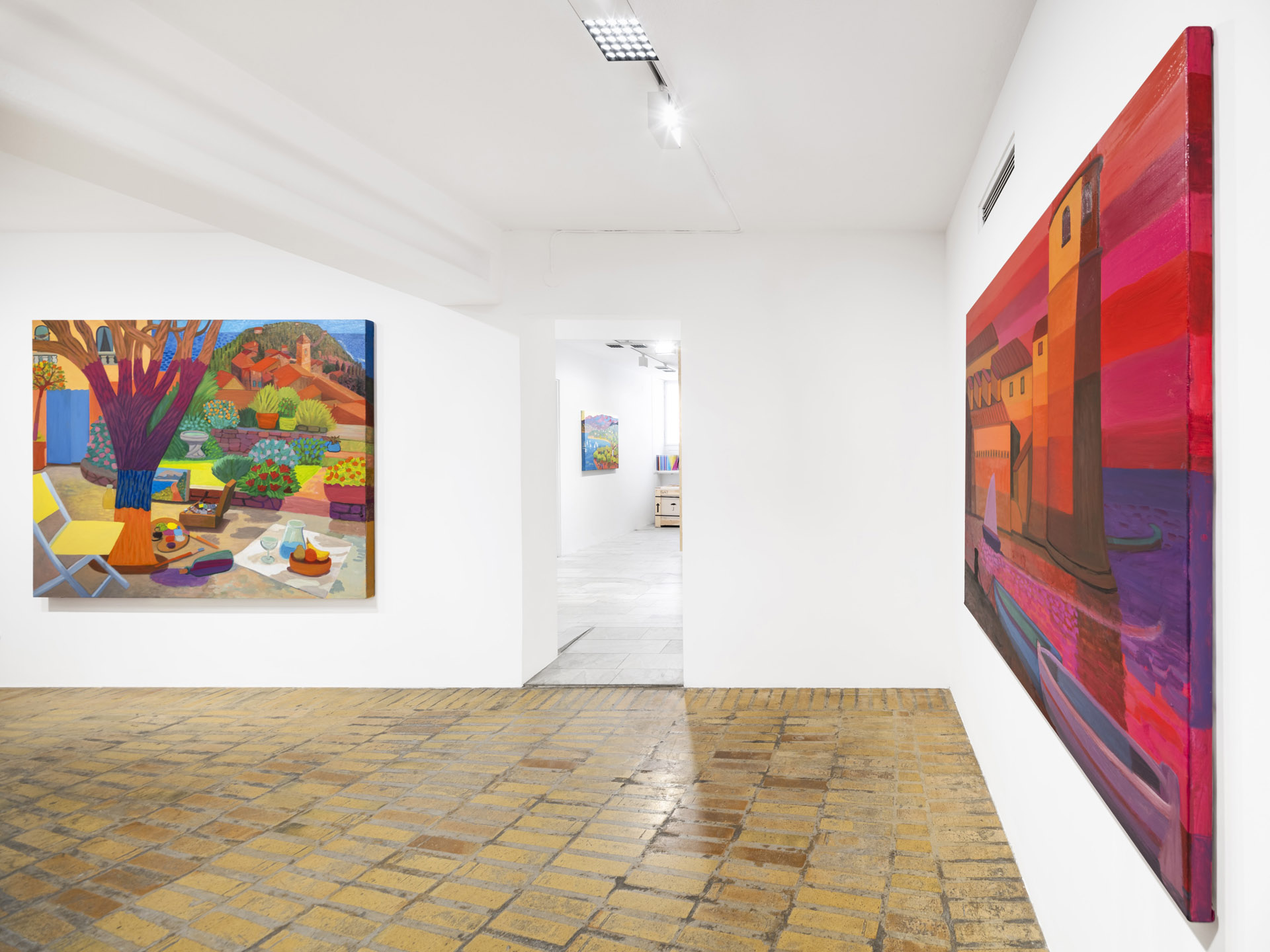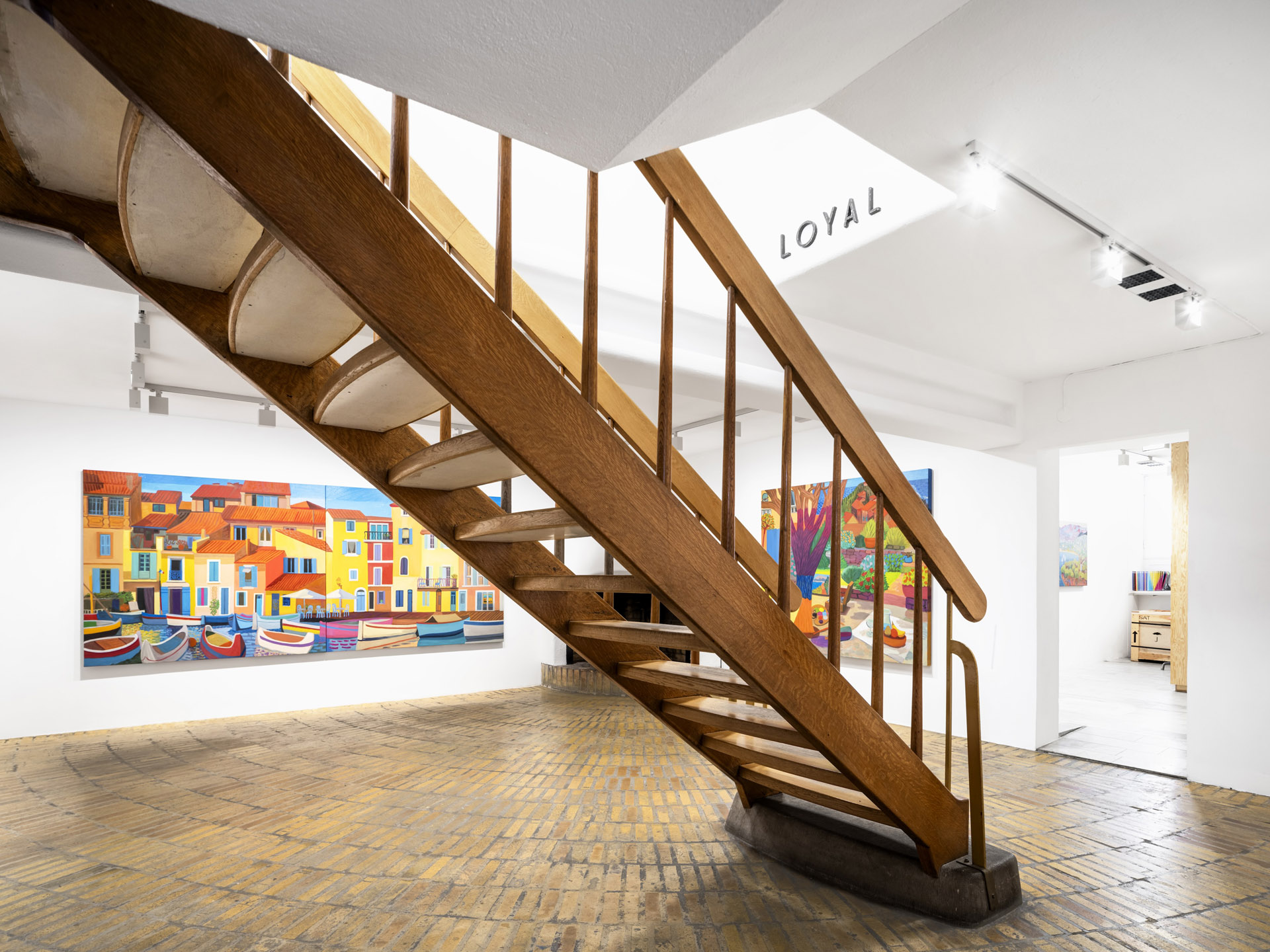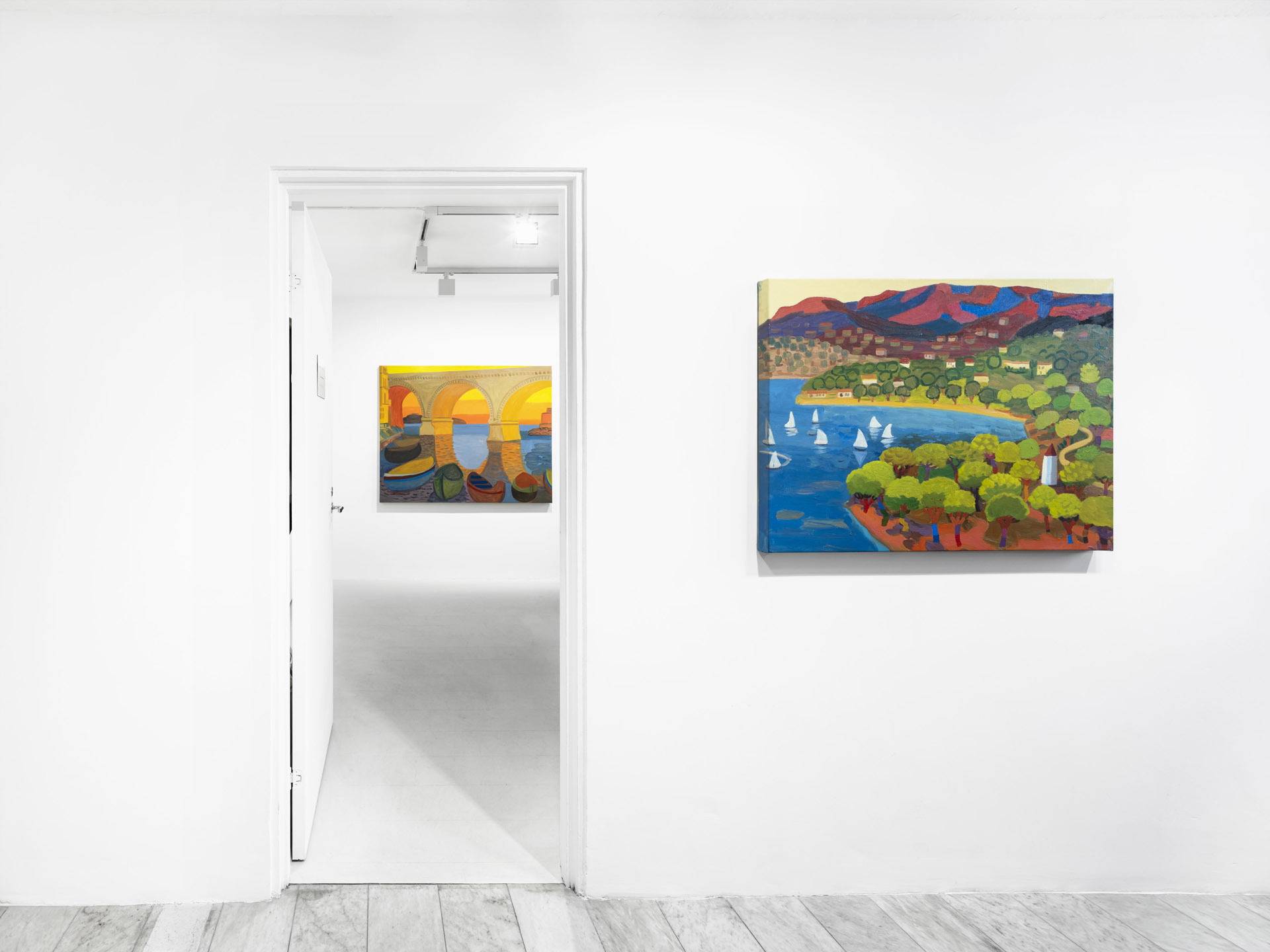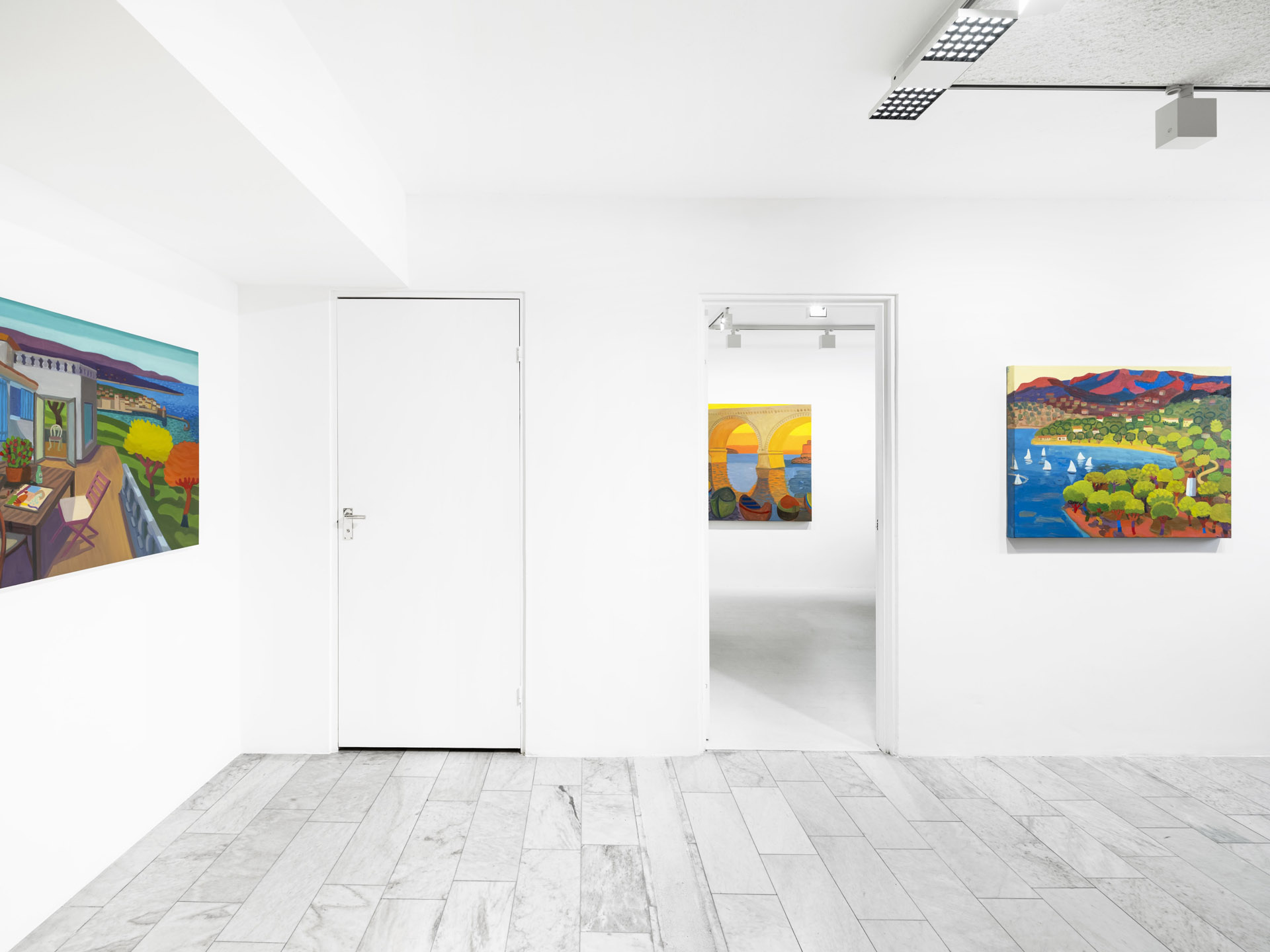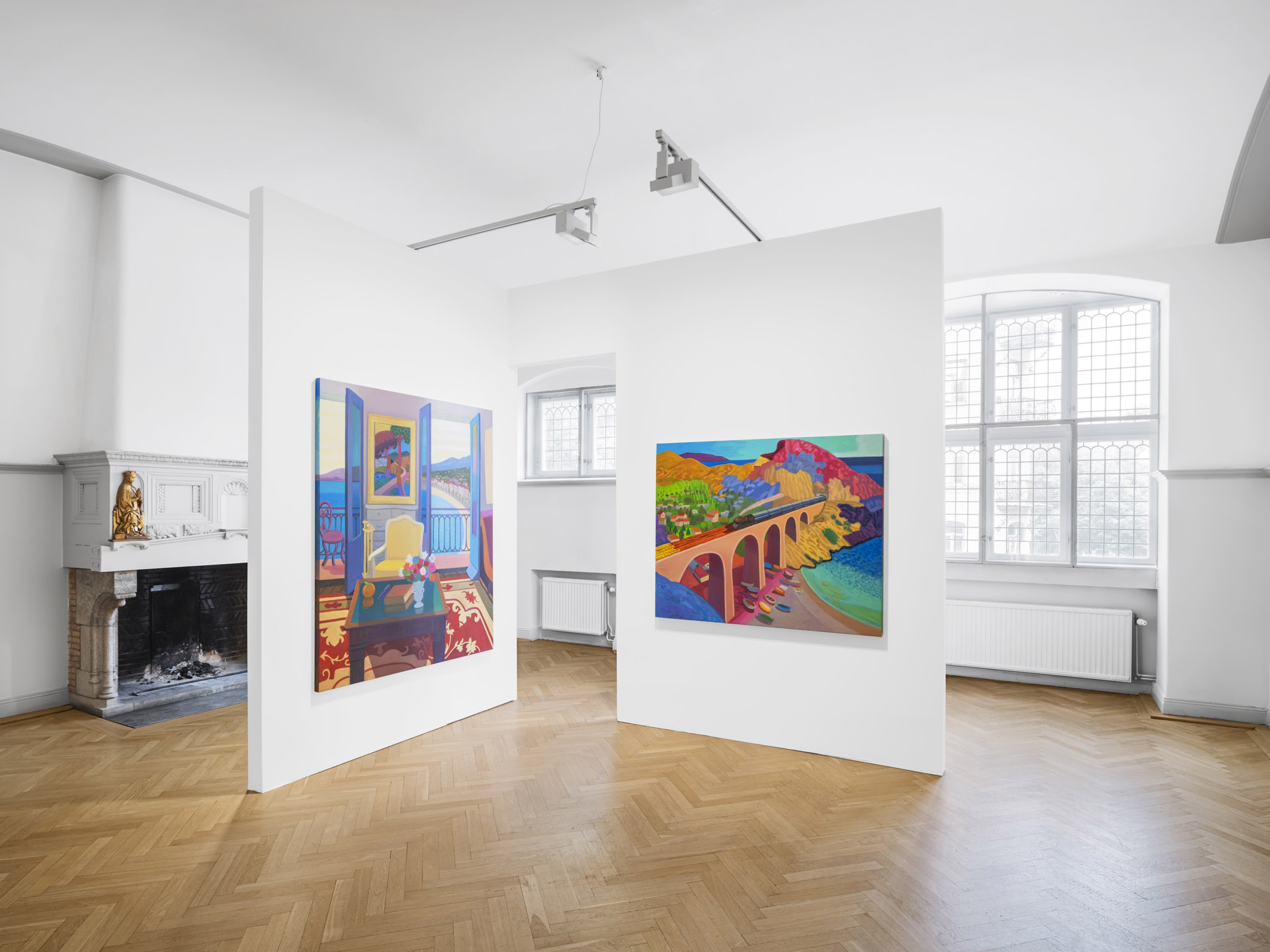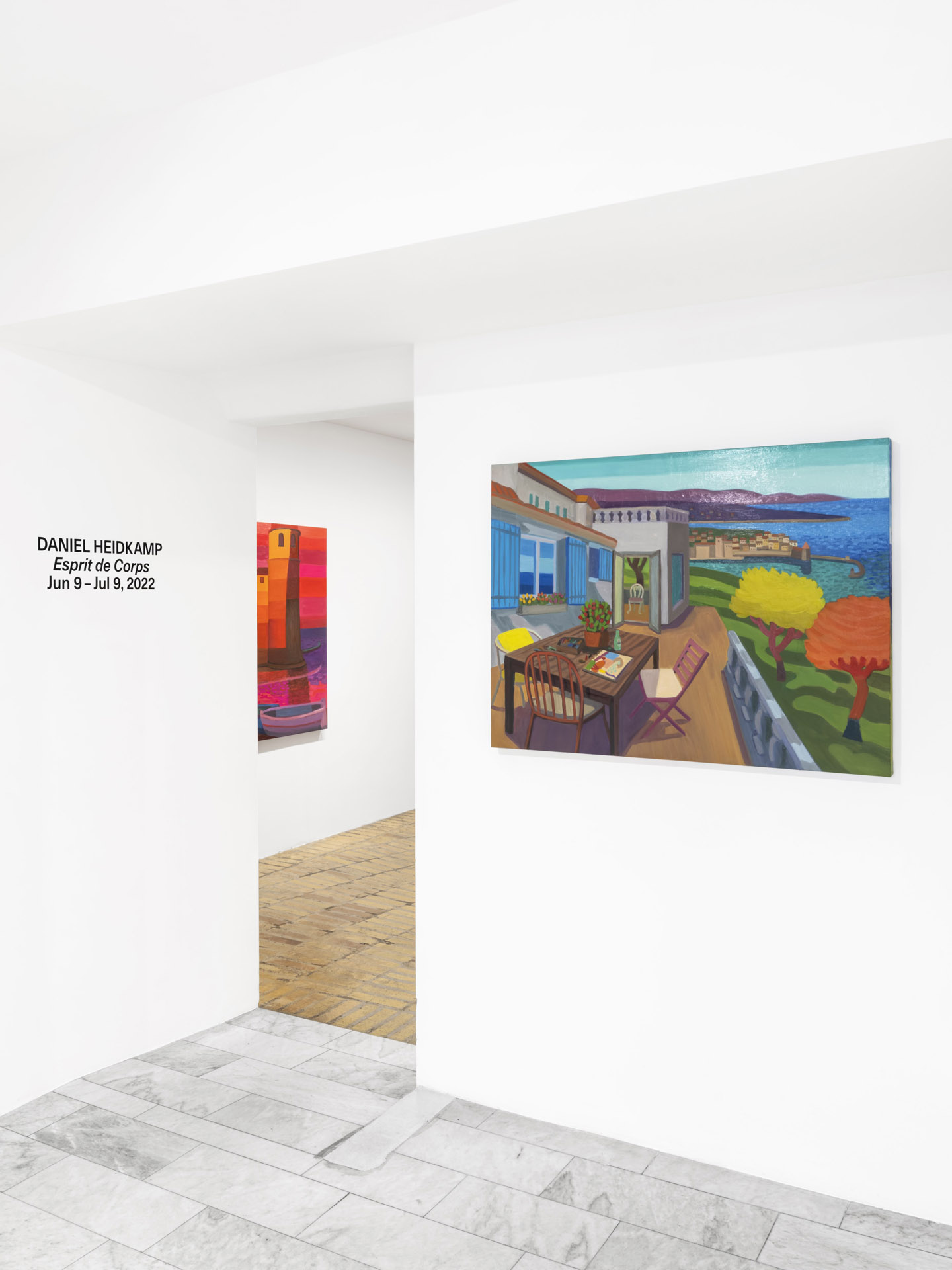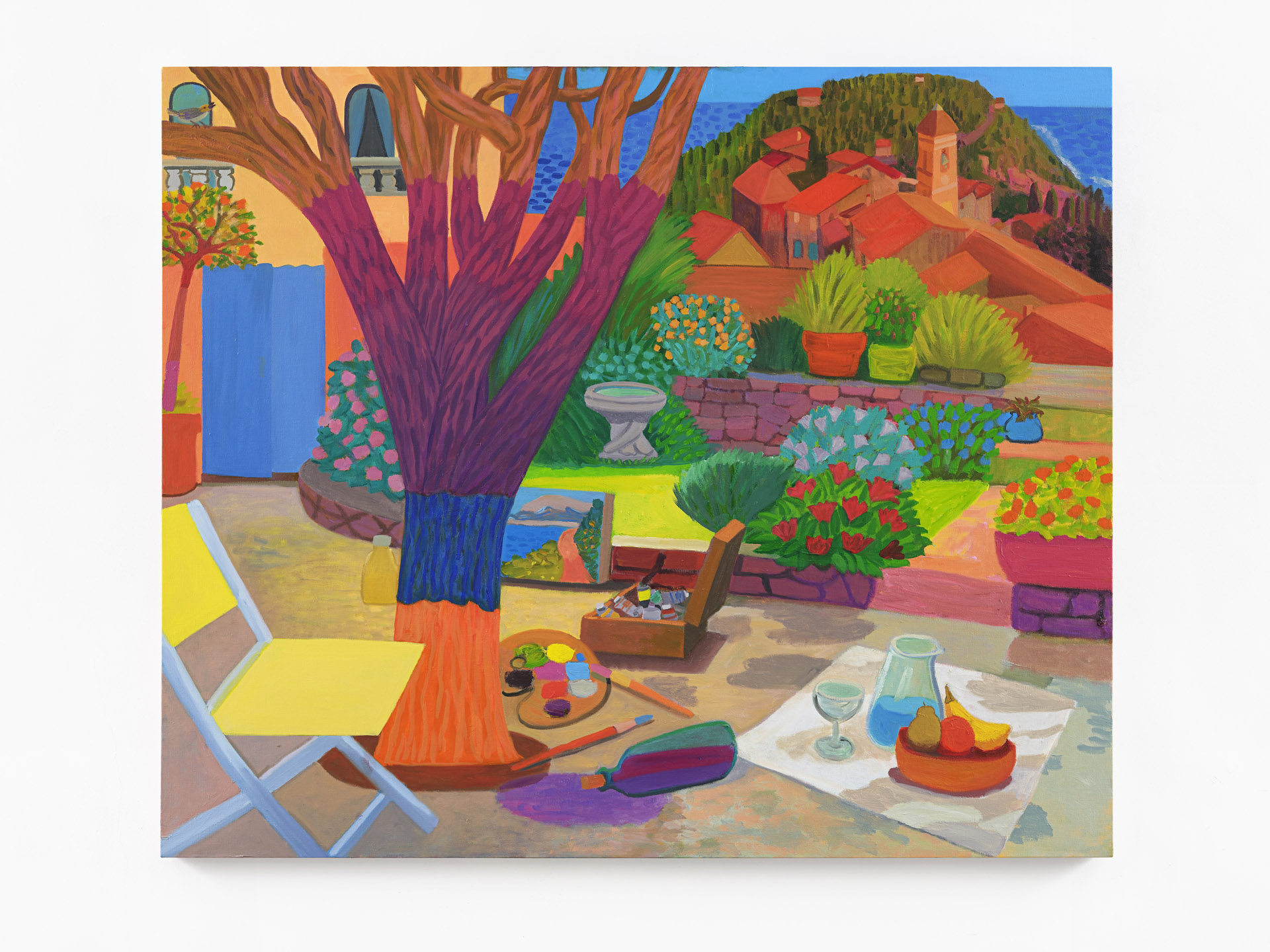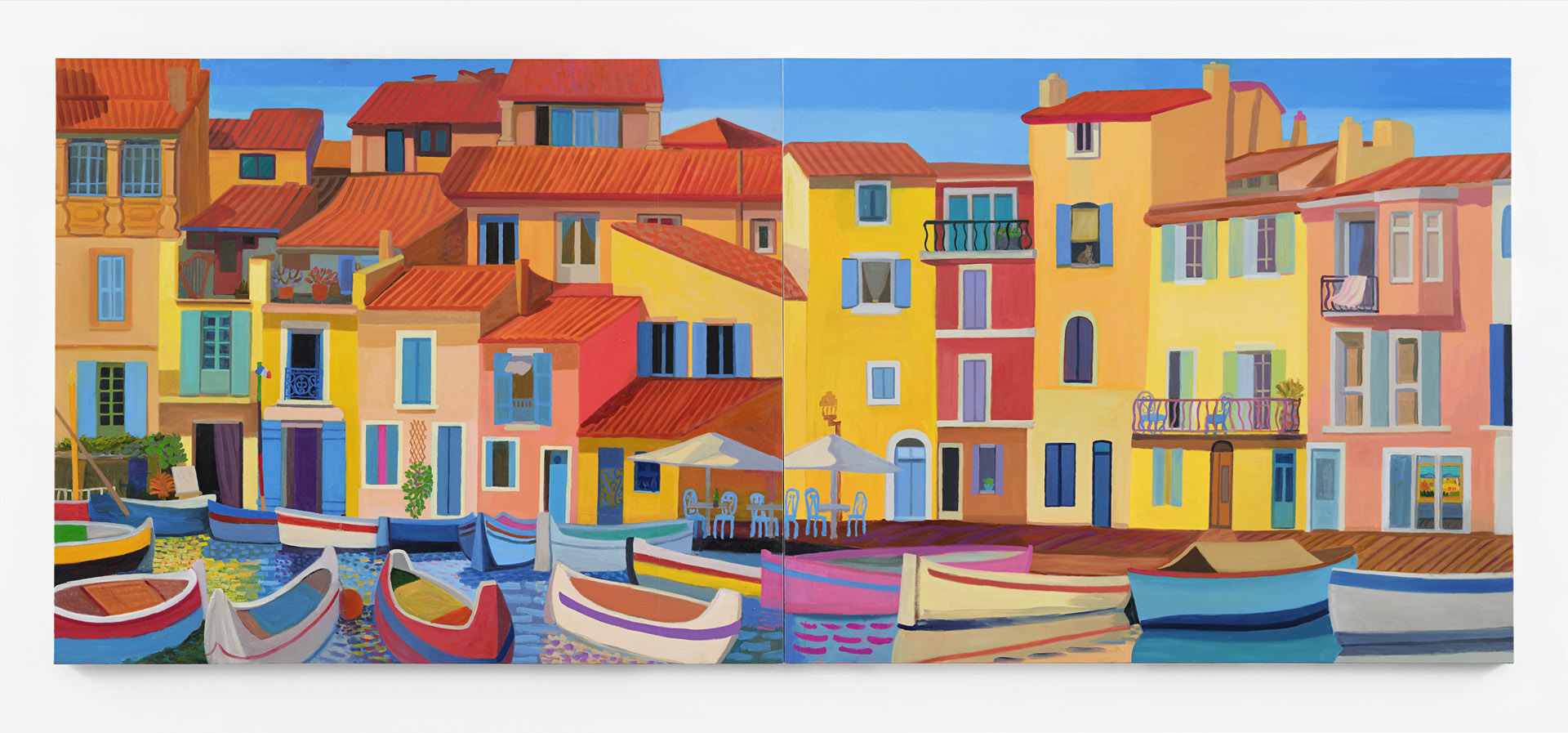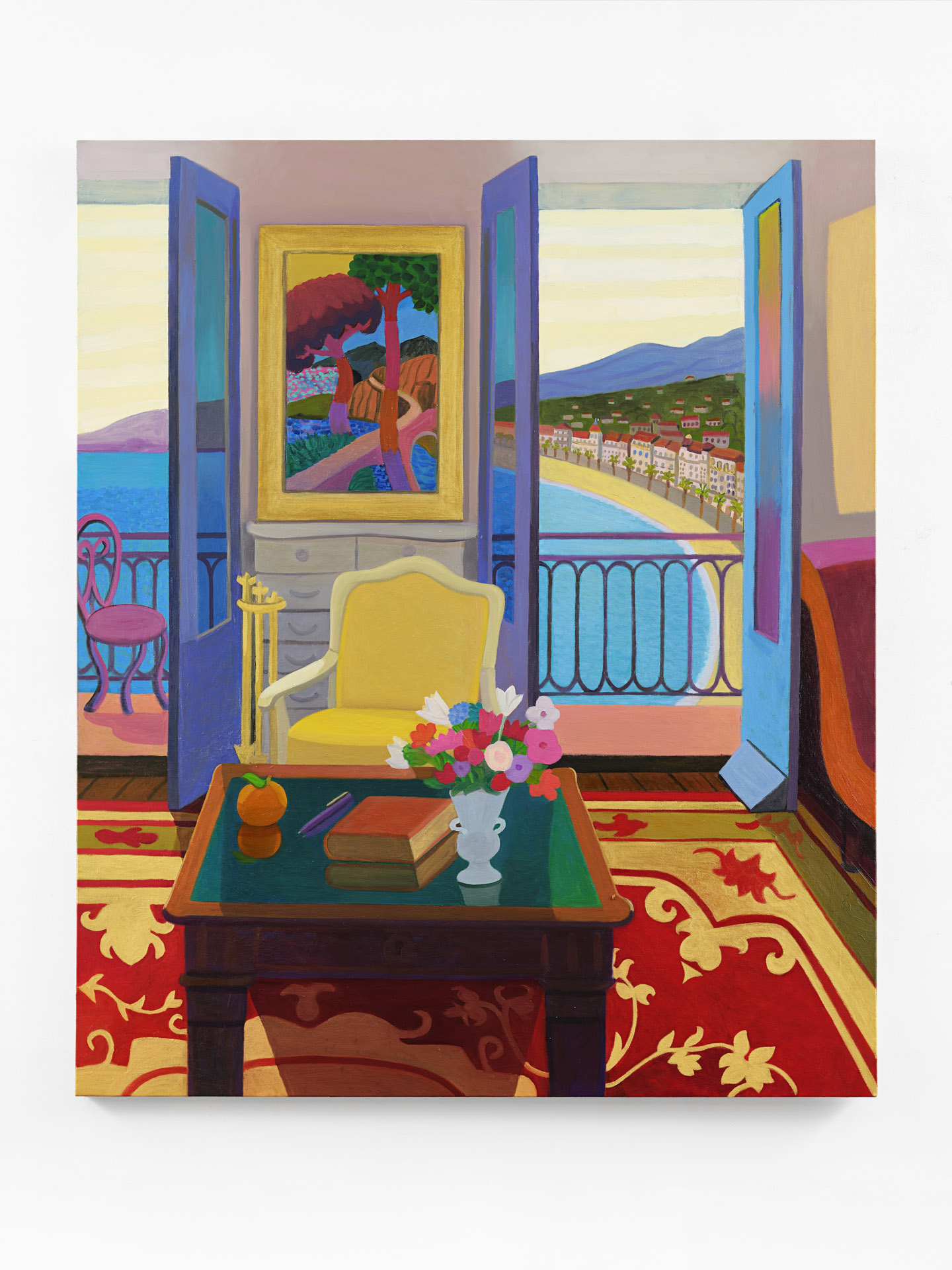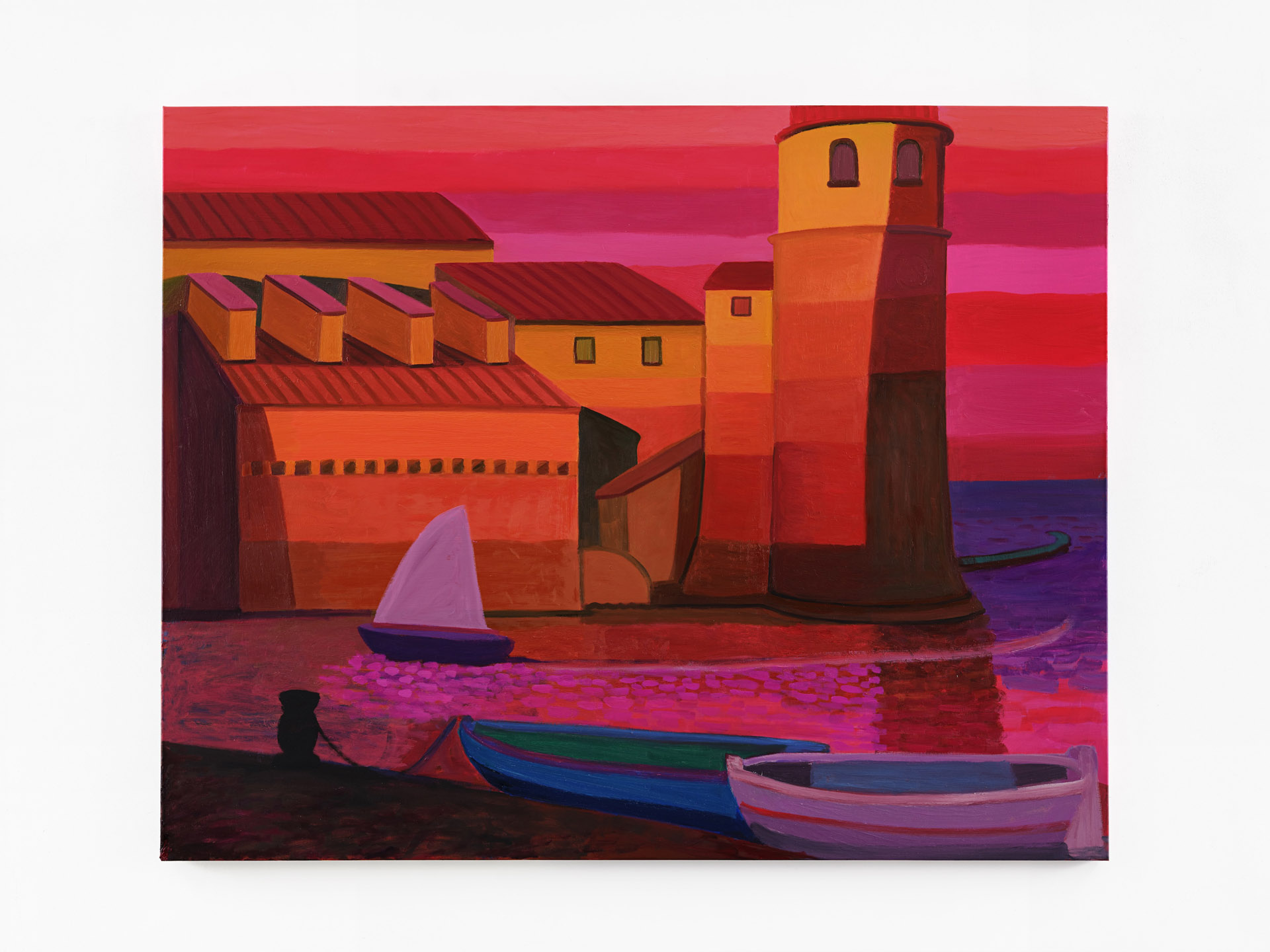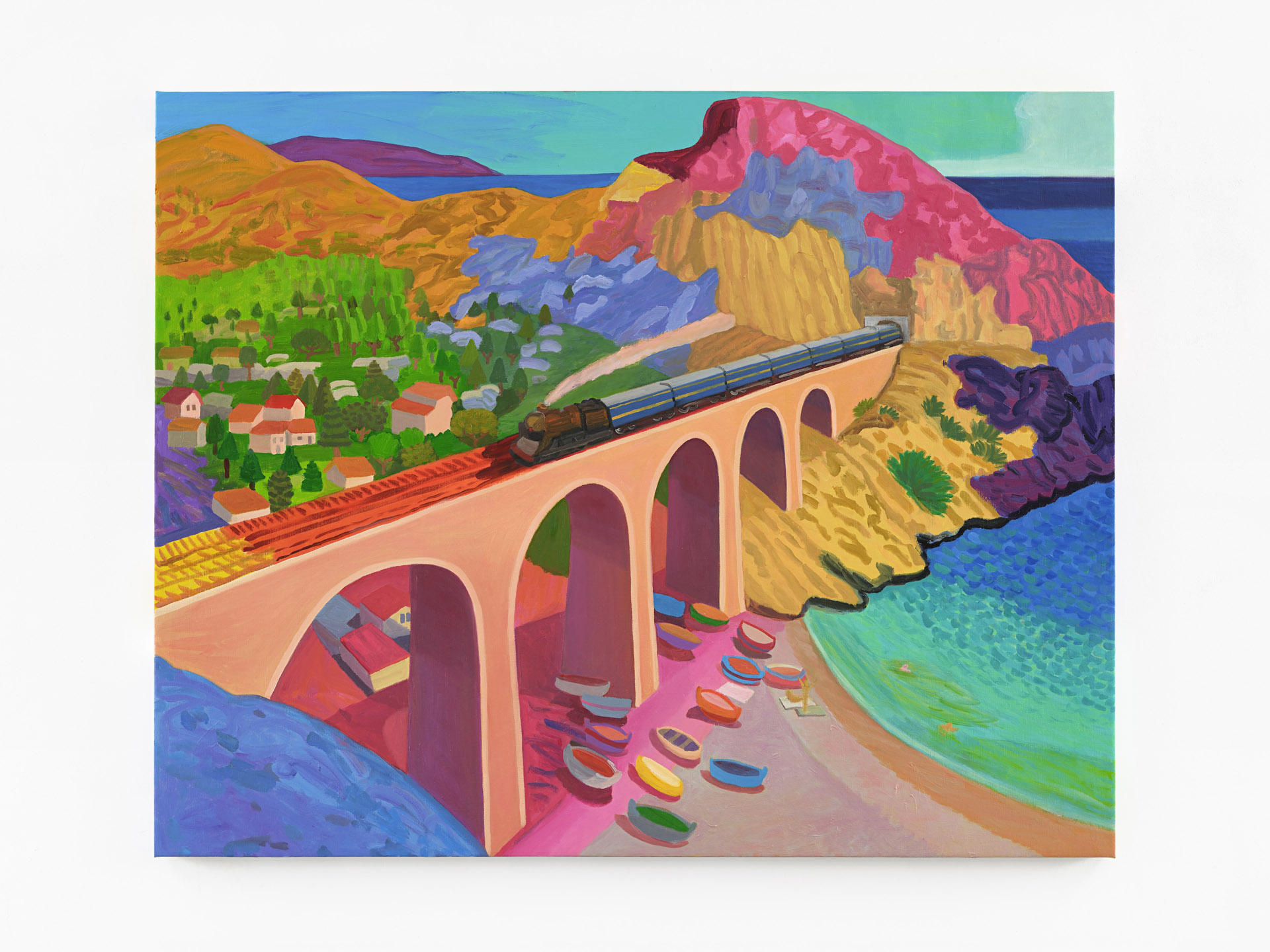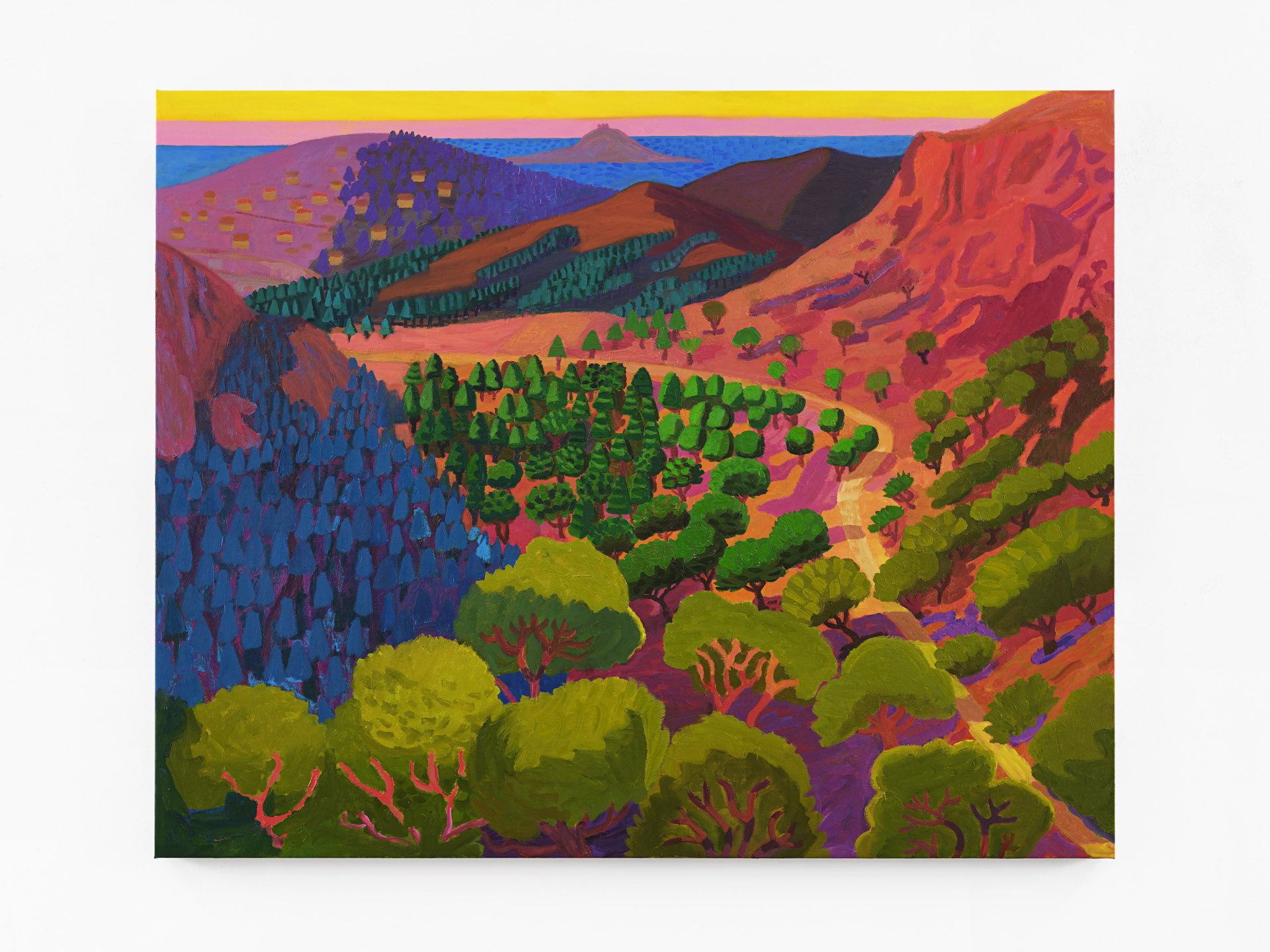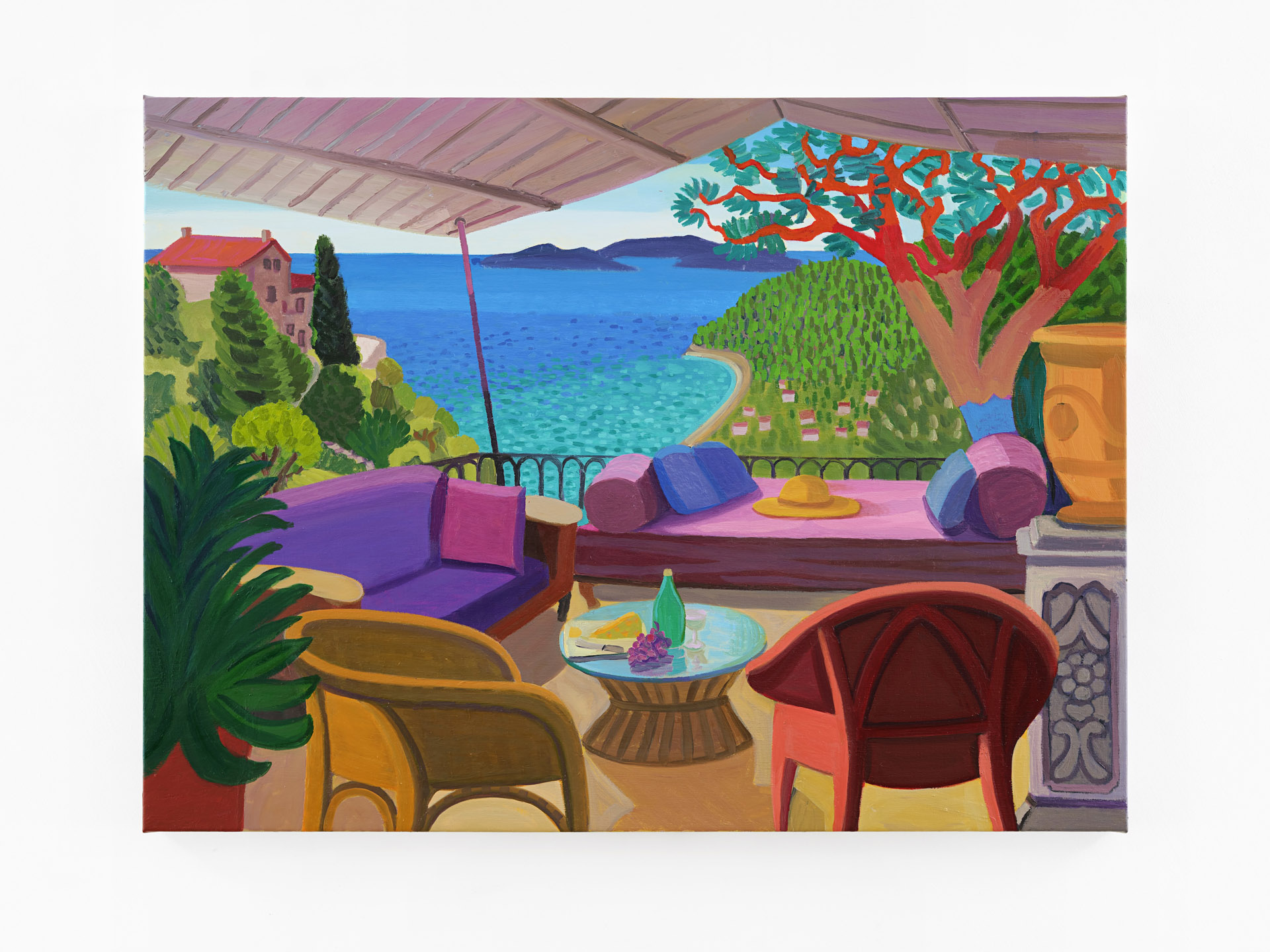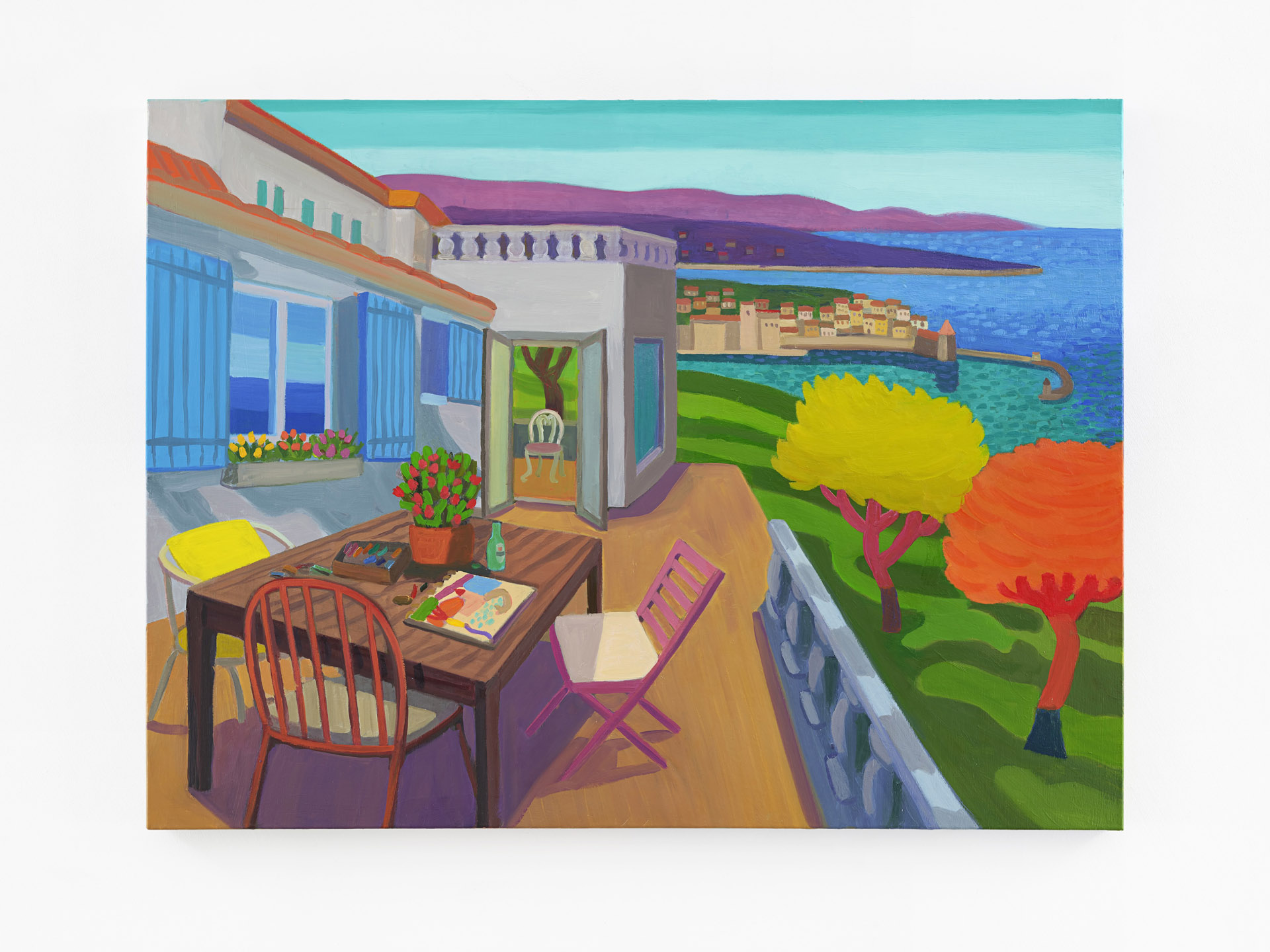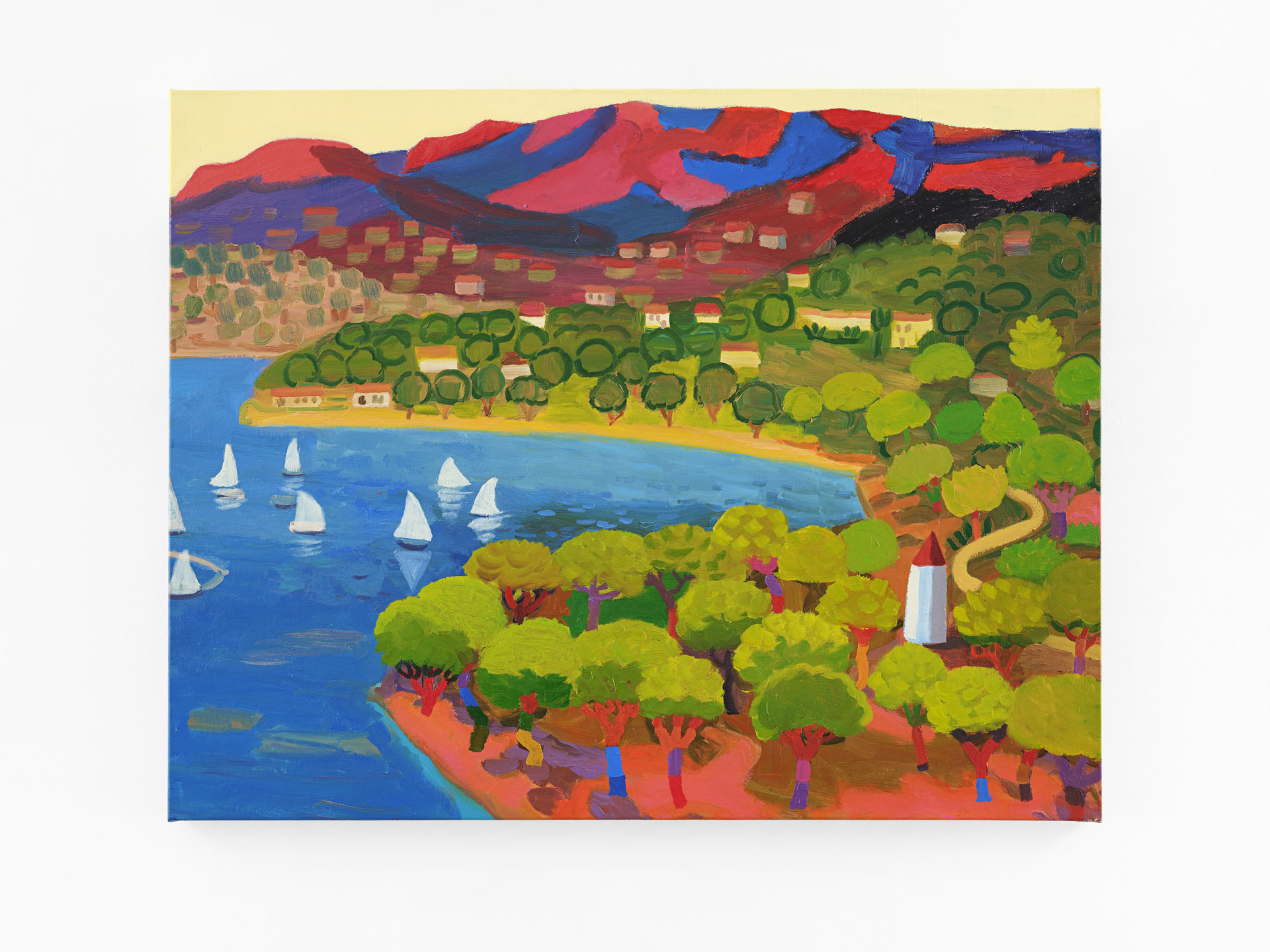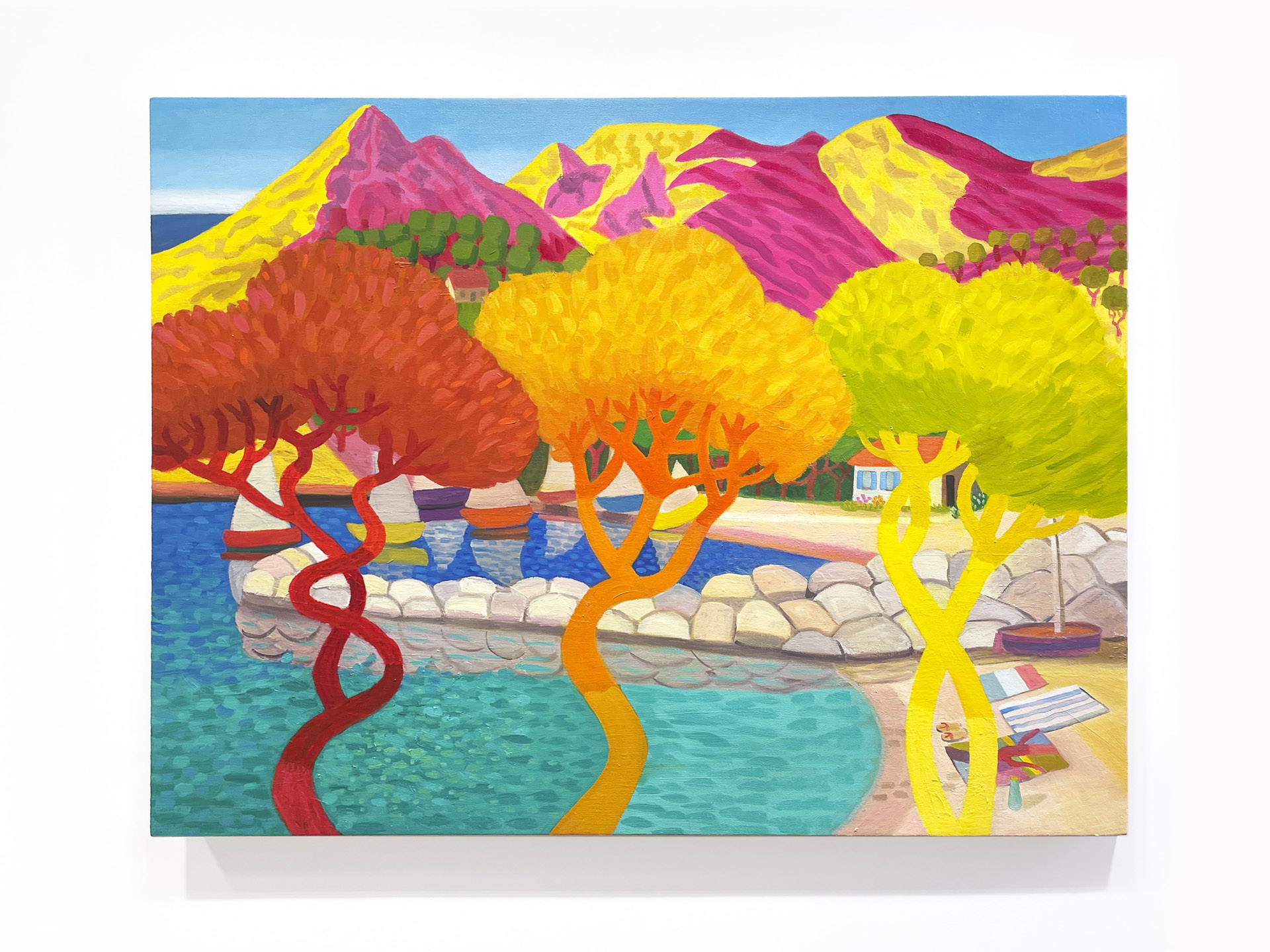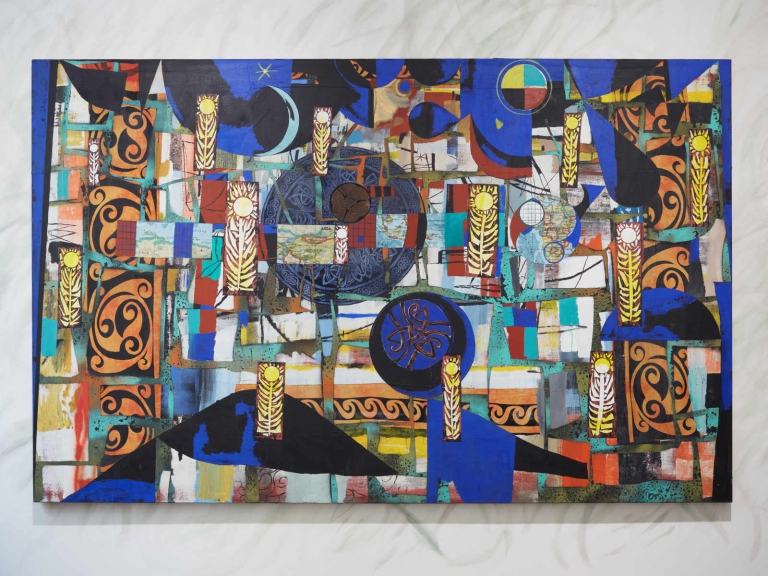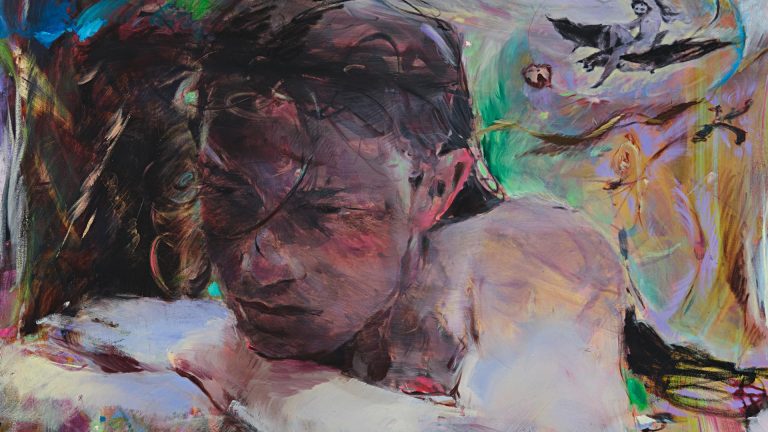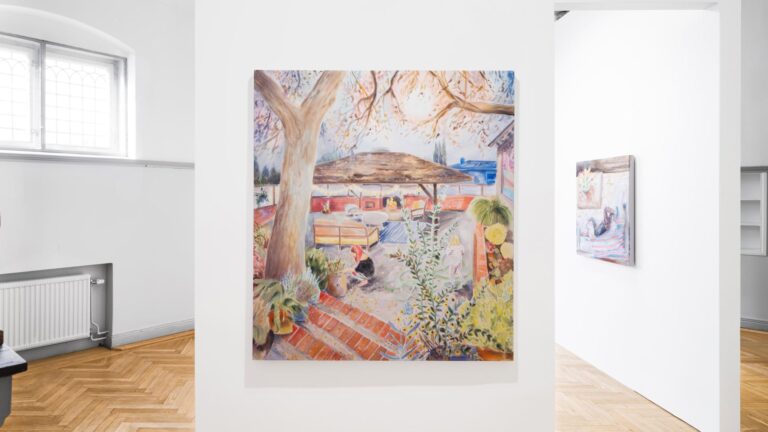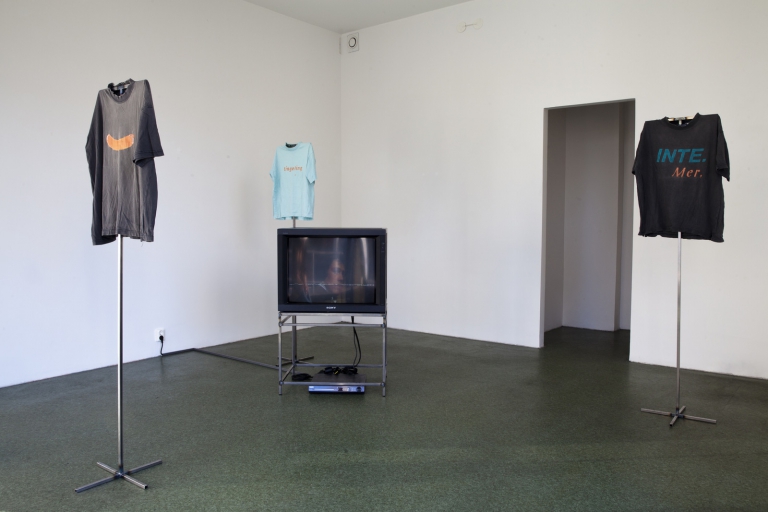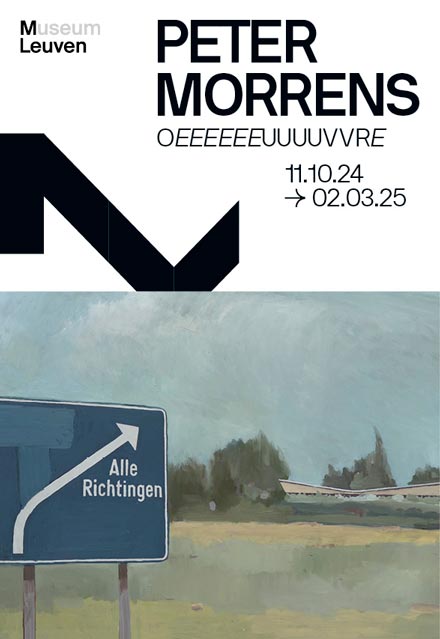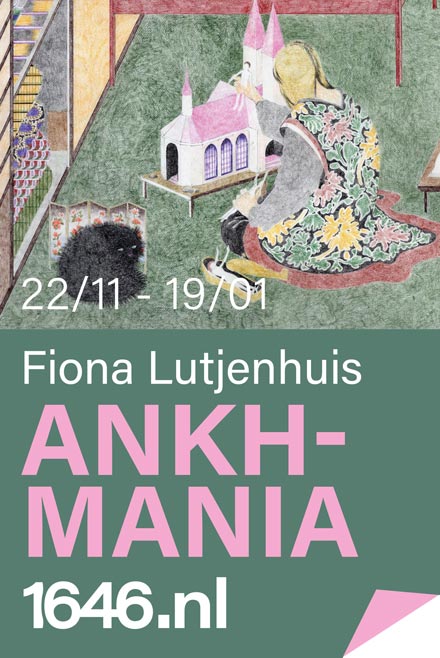Artist: Daniel Heidkamp
Exhibition title: Esprit de Corps
Venue: LOYAL, Stockholm, Sweden
Date: June 9 – July 9, 2022
Photography: all images copyright and courtesy of the artist and LOYAL, Stockholm
Loyal is proud to announce a solo exhibition with Daniel Heidkamp. “Esprit de Corps” is the New York artist’s third solo exhibition with the gallery. The exhibition presents a new suite of eleven oil paintings installed over two floors of the gallery. We would like to welcome you to the opening reception with the artist on Thursday, June 9th from 5 to 8 pm. Come celebrate Daniel Heidkamp and the start of summer with us. Natural wines will be served in the garden.
LOYAL: Let’s begin by talking about where these paintings are from. Your work always moves geographically between exhibitions. Why do you think you are interested in painting these sites? Where is the imagery from, and why focus on these images?
DANIEL HEIDKAMP: The jumping off point for this series is the Mediterranean coast of France from Collioure on the western edge all the way to Menton in the East. France is home to such an elaborate art history and offers a rich visual world for painting — there is always a medieval bell tower, or an arching viaduct, or a bending pine tree right where you need it.
L: The history of painting is your subject matter in a way. Many of the sites in your work have been painted throughout art history by figures like Matisse, Braque, Cezanne, Dufy. You are tapping into this history of new ways of seeing and showing the world. How is your way of showing it related to their ways, and how is your way different?
D: I feel alot of frisson in that time period and am drawn in by those artists’ emphasis on color and breaking away. I am inspired by how those artists established a new way of seeing, but I am also curious about what they were actually seeing in order to end up with those conclusions. In some ways I’m running the playbook in reverse. When I show up at the site I see how the scene actually looks and then how some of the earlier paintings look, which is often a colorful hot mess! I then set out to make my own painting with all this information in the mix. Ultimately I aim to come up with yet another way of looking at or representing things from my own point of view.
L: What does it mean to update those paradigms?
D: For me there are a few reasons to try to investigate or update these paradigms. One is that having this amount of density in the visual field and art historical context really benefits the painting and the process. It’s strange, but without these things, like if my subject is just a place around the block, things don’t necessarily pop off the same. Second is to help re-establish the connective tissue from earlier painting until now, which through the course of modernism and post-modernism, has been broken down and severed. Artistic strides have been made through this century long process, but other things that are important to painting have been lost. I want to share in mending that thread.
L: Regarding the importance of your trips to France and locations of paintings that were important to the birth of Cubism, I remember you saying something about that through your paintings, you were envisioning a timeline in which Cubism hadn’t taken over and become the foremost movement from that era. Like you are continuing the timeline to pick up where Fauvism left off? Can that be said?
D: I’m definitely more of a fan of Fauvism, but I like discovering the places that Cubism begins to pop up. Of course some of the same artists that were part of Fauvism were also the ones who switched to or established Cubism, especially Cezanne and Braque. I like how parts of Cubism arise from landscape painting, and zoning in on where those moments appear, like looking across a rocky Calanque and seeing the shadows under the distant trees — that looks to me like the hash marks of Cezanne. Or in the Martigues painting how the houses stack up like blocks or cubes, and the arches and viaducts are like Braque’s early Cubist paintings. For me it’s like standing at a crossroads and you can see a little down the path that others took towards Cubism, but then opting to go a different way.
L: Do you have certain paintings that become extra important to you that you decide to track down where they are painted?
D: For this show I was drawn to Collioure, and especially the bell tower that Matisse and Derain painted. I was also fascinated by the series of interiors that Raoul Dufy painted at the Hotel Suisse where he kept a studio for some time. I was able to book a room in the hotel, perhaps the very same room because the view was almost exact. My painting is something of an amalgam between Dufy’s scene and how it looked to me today. This connection to earlier artists and movements, sometimes literal sometimes in spirit, generates in me a feeling of camaraderie and purpose, and inspired the title of the exhibition: “Esprit de Corps”.
L: Do you think about the way things repeat over and over again, or the cycles of time and how it is that the human scenarios change over time, but the rocks and trees and landscape remain? Do you think about how the world you inhabit today differs from their world and the factors at that time, or are you trying to filter that all out?
D: When you look around it’s obvious that the world is different, but I like to imagine the ways that things are basically always the same, and how human nature has a way of operating no matter what. This is possible especially in France where a lot of the streets and buildings are centuries old, and you know for instance there was always a tavern on that corner with people spilling out, just like now. I think for my painting it is helpful to filter out some of the modern static, and try to go for a timeless feel. The old objects and buildings seem to come out better in paint, so while the imagery might be perennial, hopefully in my style, touch, and attitude it will show that these are painted today.
L: You have also talked about the importance of something you call “art energy” that you feel in sites and locations where significant paintings have been made in the past, that were visited by artists and inspired significant artworks to happen. To take in the light and atmosphere, and “tap into” this as an artist living today, to see what happens to you in those sites. What do you see as the most significant intervention you make into these art historical places you revisit throughout the many series you have explored, from Cape Ann, to the Black Forest, to Nice and Marseille, to Yosemite.
D: I think the main intervention is to utilize these places at all amid a contemporary art world that has largely forgotten them. It’s interesting to visit these places and in many circumstances (but not all) see how much the history is celebrated at that site, with sign posts and monuments, but it’s usually in a bubble that doesn’t ripple out past the local ambiance. Then my other intervention is to be one artist who visits very many of these sites across different lands and sort of ties them all together through one vision. I like to check in on these places and see if the “art energy” is still intact. In a place like Collioure it seems to have looked exactly the same for a thousand years, while in La Ciotat there is a big shipping crane and parking lot amid the beauty. I think part of how it informs my work is to look at the site, then look at the historical painting and you can begin to see the things that the artist changed and what looks the same, and it helps me understand a way of seeing, and interpreting, and strategies around making a painting. Sometimes when you look at an older painting (especially the Fauves) it looks wild and abstract, by visiting the site you can figure out what they were actually looking at and unscramble the egg a little bit.
L: In what way do you see your paintings as related to each other, rather than related to the paintings they inhabit?
D: I think the style, surface, color connect the paintings. I think the quest for creating a sense of light, glow, and vibration also brings these together. I think my paintings all have a connection to abstraction, and exploring paint as paint, but conversely usually have a sense of narrative and storytelling.
L: Can we talk about the different bodies of work in your practice? There are landscapes, interiors, cityscapes, nightscapes, portraits, right? Is it one body of work, evolving over time?
D: I think it is one body of work with different notes or movements. And yes, it is evolving as I discover and explore different techniques but also try not to let go of what was already good. Painting can be very complicated and elusive even after all these years, which keeps me reaching over time.
L: Can you talk about your process a little bit?
D: Most of my time is spent painting in my studio in Brooklyn. The jumping off point of each painting begins with an inspiring location, in the best circumstance I am able to make a small painting or drawing at that location, as well as take a bunch of photographs. Then back in the studio I begin to compile my various source material often into a medium size oil pastel work on paper. This helps me see if the composition will hold up as a larger painting and helps me begin to experiment with color. Once I feel good with the study, I set out on the larger oil painting. Throughout the entire process I am making changes and adjustments, there is a lot of organic mark making, revision, and even struggle as I aim to realize the finished painting.
L: What are the different components you look for when making a composition? I love the inclusion of the palette in “Roquebrune” because of the implication of the painter. The palette is where the power lies. Within this colorful palette, who is controlling the image.
D: I think most of my paintings have several almost different smaller themes or mini paintings compiled into one image. For instance in the interior where you see both the “cityscape” of Nice, as well as the still life objects of the room. Or the Roquebrune garden with the painter’s set up, as well as the medieval village, and also the canvas leaning on the wall that shows Cap Martin from a different angle which is a nod to a famous Monet painting made near that site. I like to try to pack things into all the corners of the painting, but in a way that gels to create one unified composition.
L: Usually in your paintings you get a sense of vitality, freshness, and movement through the brushstrokes and color. Is this something you intentionally focus on, and do you see it as coming from a Fauvist tradition?
D: I definitely enjoy a sense of vitality and freshness in the brushstrokes. I think this is an homage to (or result of) being a representational painter in an abstract painting world. Conversely the looseness reminds me of how things look when I am painting “en plein air”. While these are studio paintings, I like the idea that these sort of feel like jumbo size outdoor paintings.
L: Do you trust your unconscious mind more or your conscious mind more? Do you set out with an idea or do you start with a question and look for what makes the best solution for the question? And if so what might a question be that you seek to ask?
D: I think I lean more on the conscious mind when figuring out the ideas around my painting. But there is an unconscious aspect that happens in the studio. I feel like that aspect comes more out of the physical body, after doing something for so many hours over so many years, the muscles, body, and vision seem to take over even without conscious thought.
L: Tell us about “Esterel”?
D: The region that inspired this painting (as well as Saint-Raphael) is a little west of Cannes and is home to the Massif de L’Esterel. Because this mountain range features cliffs of bright red rocks, and comes right up to the edge of the turquoise blue sea, it offers a surreal color field that has been a beacon to artists over the decades. Both Monet and Renior painted in these hills, but it was probably André Derain who was most able to exploit the electric colors in his painting “The Côte d ‘Azur near Agay”. During my travels we were able to make the hours long hike up to one of the red rock peaks to capture the view for Esterel.
L: Can you tell us more about the exhibition title “Esprit de Corps”?
D: For me the title points to the feeling of connection and commaraderie among artists and locations, both past and present, literal and in spirit, and to the new friends I’ve made along the journey. Part of making a painting is a very solitary act, but in another way it is something that comes out of the effort of many, whether it is other artists from the past who you are allowed to lean on for inspiration, friends, viewers, and gallerists who join in a dialogue around the work that can help things bloom, and even the people of France who do a wonderful job in preserving and celebrating the culture and environment that makes it still possible to create a great work of art. I also like how in the definition of “Esprit de Corps” the word “loyal” comes up—this is definitely a wink to this special gallery, and also says something about the role of the painter, not only expressing something about themselves but loyal to the tradition and cause of art and enthusiastically helping to carry that forward to the next generations.
Daniel Heidkamp (born 1980, Wakefield, MA) lives and works in New York. He received his BFA from School of the Museum of Fine Arts, Boston, MA in 2003. His work is currently on view in the exhibition Unnatural Nature: Post-Pop Landscapes, curated by Todd Bradway at Acquavella Galleries in New York, showing alongside Jules de Balincourt, David Hockney, Alex Katz, Hayley Barker, Nicolas Party, Nicole Wittenberg, Matthew Wong, Ann Craven, Lois Dodd, Maureen Gallace, among others. Solo exhibitions include Half Gallery (New York), Loyal Gallery (Stockholm), Pace Prints (New York), White Columns (New York), The Journal Gallery (New York). Heidkamp is featured in the book Landscape Painting Now published by D.A.P. Heidkamp’s work was included in the exhibition “Talking Pictures” at The Metropolitan Museum of Art in New York in 2017, and his work from this exhibition is now included in The Met’s permanent collection.
Daniel Heidkamp, Esprit de Corps, 2022, exhibition view, LOYAL, Stockholm
Daniel Heidkamp, Esprit de Corps, 2022, exhibition view, LOYAL, Stockholm
Daniel Heidkamp, Esprit de Corps, 2022, exhibition view, LOYAL, Stockholm
Daniel Heidkamp, Esprit de Corps, 2022, exhibition view, LOYAL, Stockholm
Daniel Heidkamp, Esprit de Corps, 2022, exhibition view, LOYAL, Stockholm
Daniel Heidkamp, Esprit de Corps, 2022, exhibition view, LOYAL, Stockholm
Daniel Heidkamp, Esprit de Corps, 2022, exhibition view, LOYAL, Stockholm
Daniel Heidkamp, Esprit de Corps, 2022, exhibition view, LOYAL, Stockholm
Daniel Heidkamp, Esprit de Corps, 2022, exhibition view, LOYAL, Stockholm
Daniel Heidkamp, Esprit de Corps, 2022, exhibition view, LOYAL, Stockholm
Daniel Heidkamp, Esprit de Corps, 2022, exhibition view, LOYAL, Stockholm
Daniel Heidkamp, Esprit de Corps, 2022, exhibition view, LOYAL, Stockholm
Daniel Heidkamp, Esprit de Corps, 2022, exhibition view, LOYAL, Stockholm
Daniel Heidkamp, Esprit de Corps, 2022, exhibition view, LOYAL, Stockholm
Daniel Heidkamp, Esprit de Corps, 2022, exhibition view, LOYAL, Stockholm
Daniel Heidkamp, Esprit de Corps, 2022, exhibition view, LOYAL, Stockholm
Daniel Heidkamp, Esprit de Corps, 2022, exhibition view, LOYAL, Stockholm
Daniel Heidkamp, Esprit de Corps, 2022, exhibition view, LOYAL, Stockholm
Daniel Heidkamp, Esprit de Corps, 2022, exhibition view, LOYAL, Stockholm
Daniel Heidkamp, Roquebrune, 2022, Oil on linen, 60 x 72 in (152 x 183 cm)
Daniel Heidkamp, Breeze in Martigues, 2022, Oil on canvas, (diptych) 60 x 144 in (152 x 366 cm)
Daniel Heidkamp, Suisse Nice, 2022, Oil on canvas, 72 x 60 in (183 x 152 cm)
Daniel Heidkamp, Pink Collioure, 2022, Oil on linen, 48 x 60 in (122 x 152 cm)
Daniel Heidkamp, Blue Train, 2022, Oil on linen, 48 x 60 in (122 x 152 cm)
Daniel Heidkamp, Starry L’Estaque, 2022, Oil on linen, 48 x 60 in (122 x 152 cm)
Daniel Heidkamp, Esterel, 2022, Oil on linen, 48 x 60 in (122 x 152 cm)
Daniel Heidkamp, Eze, 2022, Oil on linen, 30 x 40 in (76 x 102 cm)
Daniel Heidkamp, Colors of Collioure, 2022, Oil on linen, 30 x 40 in (76 x 102 cm)
Daniel Heidkamp, Saint Raphael, 2022, Oil on linen, 30 x 38 in (76 x 97 cm)
Daniel Heidkamp, La Plage, 2022, Oil on linen, 36 x 48 in (91 x 122 cm)

